
JIMMY COMPETES WITH HIS “SOULMATE” (EARTHA KITT) FOR THE LOVE OF PLAYBOY, PRODUCER, & THEATER MOGUL
ARTHUR LOEW, JR.

Sammy Davis, Jr.
“I’m hot shit,” James Dean bragged on the phone to his friend, William Bast, who was still struggling to find his niche as a writer. “I guess I can now have any role I want in this town.”
“Enjoy your moment,” Bast said, trying to conceal his jealousy. “Hollywood is known for crowning princes, occasionally even kings. It’s also known for dethroning them, sometimes after very short reigns. Then an actor’s got to live with his fall from glory for the rest of his miserable days.”
“What a downer you are,” Jimmy charged, flashing anger. “Don’t ruin my moment. Why don’t you admit it? You’re a failed actor. You’d love to be in my position.” Then he slammed down the phone.
It would be several days before he spoke to Bast again.
But as he’d soon discover, Hollywood wasn’t ready to give him any role he wanted.
Producer John Houseman had met him at a party, finding him an ideal choice to play the role of a mentally disturbed youth in an upcoming film, The Cobweb. It had been written by John Paxton, who had penned the script for Marlon Brando’s The Wild One based on a novel by William Gibson.
At a lunch, Houseman handed Jimmy the rough draft of The Cobweb’s script. Jimmy would later refer to it as “Grand Hotel in the Loony Bin.” The plot dealt with a series of melodramatic events in a high-class mental institution. The role being discussed was that of Steven Holte, a troubled young designer with mental problems. Jimmy found the character “sweetly deranged. It’s practically type casting,” he said in a phone call to Houseman the next day.
Houseman arranged for Jimmy to drive, the following night, to the home of Vincente Minnelli, who was set to direct it. “I hope Judy Garland’s former husband is not going to turn this into a musical.”
“Have no fear,” Houseman assured him. “He’s equally good at dramas. He should know a lot about mental institutions, having been married to Judy.”
Over drinks in Minnelli’s living room, Jimmy told him that he had come very close to working with him before on The Bad and the Beautiful (1952), the film he’d directed with Lana Turner and Kirk Douglas. “George Bradshaw wanted to do something really daring. Instead of Lana catching Kirk with another woman, she goes to his house and discovers me in my panties coming out of Kirk’s bedroom. It would have been ground-breaking.”
“I’m aware of that and actually wanted to film it,” Minnelli responded, but, of course, MGM nixed the idea as too daring. The Production Code just wouldn’t have allowed it.”
Minnelli had already nicknamed The Cobweb “our mental film,” and told Jimmy that he was hoping for an all-star cast. “You’ll get that chance to work with Lana after all. I’ve offered her a role along with Robert Taylor and Grace Kelly. Not bad. Three of the biggest stars in Hollywood…and you. The movie has a perverse fascination for me. I’m familiar with the psychiatric setting after all those years with Judy, including time at Menninger.”
[The Menninger Clinic, a respected drug and alcohol rehabilitation center that at the time was located in Topeka, Kansas (and now located in Texas), had, for a while enrolled Judy Garland in one of its programs.]
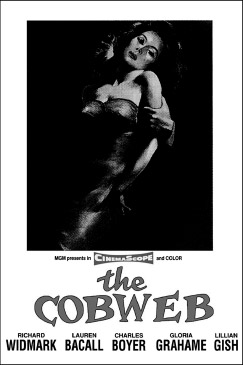
Jimmy also said that he was looking forward to working with Susan Strasberg, daughter of Lee, who had been cast in the film as one of the mental institution’s patients.
He was also impressed with the rest of the cast. “Fay Wray from King Kong. My God. And Adele Jergens. Ronald Reagan proposed marriage to her after Jane Wyman dumped him. Lillian Gish is also in Cobweb. What a dear. Do you know that she ‘invented’ the close-up?’”
It was well known in Hollywood circles that Minnelli was gay, and, as Jimmy later admitted, “I was waiting for the inevitable invitation to his casting couch.”
The next day, he phoned Bast to make up with him, and to tell him what had happened at Minnelli’s home.
“Did he seduce you?” Bast asked.
“No, but his mouth was watering. I’m too big a star to lie on any more casting couches. I did wear a pair or tight jeans and no underwear to tempt him. His eyes kept darting to my crotch. I should have given the poor guy a break, but I held out. After all, I’d fucked Judy.”
When Houseman phoned Jimmy the next day, he told him, “I talked to Vincente. He thinks you’re perfect for the role. It’s yours.”
Jimmy phoned Bast again. “I got the part. And I got it without having some old guy suck my dick.”
But Minnelli’s dream cast didn’t work out. Instead, he cast Richard Widmark, Lauren Bacall, and Gloria Grahame. Taylor and Turner had drifted on to make other pictures, and Kelly claimed she was exhausted after making four films virtually in a back-to-back row.
Jimmy was delighted to learn that Leonard Rosenman, one of his best friends, had signed to do the musical score.
He was also looking forward to meeting Gloria Grahame, who had been married to director Nicholas Ray until he caught her in bed with his thirteen-year-old son, Tony. And he was especially interested in a face-to-face with Lauren Bacall.
Humphrey Bogart and Bacall lived together in Benedict Canyon a few miles north of the Beverly Hills Hotel, in a ranch-style house that had been originally built for Hedy Lamarr.
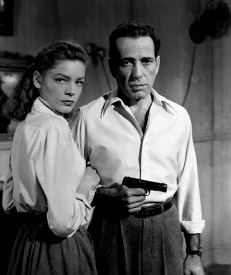
Lauren Bacall with Humphrey Bogart...a May to October affair.
Bacall called Jimmy and invited him over for a drink. She was aware that he’d played a brief role in Deadline, U.S.A, with her husband. But she didn’t know that Bogie and Jimmy had had had several vicious encounters.
Jimmy brought along a recording of some of Rosenman’s music to play for her, with the understanding that his friend had already been commissioned to compose a musical score for The Cobweb.
Bacall would later tell Patricia Neal, who had worked with Jimmy before, “I found him charming and attractive. Unlike some of these punks in Hollywood today, he seems to appreciate an older woman. Actually, I’m only eight years older than he is.”
“Many find Jimmy difficult, but I thought he was delightful,” Neal said. “Coop [Gary Cooper] just adored him.”
Neal also learned what happened later that night. “As we were listening to the music, Jimmy asked me to dance,” Bacall said. “He held me very close, pressing his body against mine.”
“All of a sudden, Bogie arrived home early and caught us dancing,” Bacall said. “He’d been to the clinic. As you know, his health is failing. It was perfectly harmless. Maybe we kissed. I don’t remember. Bogie went ballistic. He grabbed Jimmy by his neck and literally tossed him out the door on his ass.”
Jimmy fared better with another member of the cast, Oscar Levant, who had signed to play the mother-fixated Mr. Capp. In the original novel, he was a homosexual. “Minnelli wants to leave the gay stuff in, but I’m sure MGM will object. Instead, he’s having it rewritten. However, he’s bringing all my neuroses and complexes into the plot, so I will, more or less, be playing myself.”
Levant was an eccentric pianist known for his sharp tongue. His streams of barbed witticisms appealed to Jimmy’s sense of humor. A friend of Levant’s, Joan Collins, said, “Oscar and Dean were total opposites, but they got along fabulously, each relishing the other’s unusualness.”
Jimmy was drawn to Levant’s music, but he also was impressed with him as an actor. He’d appeared in Humoresque (1946), with John Garfield and Joan Crawford and in such films as An American in Paris (1951) with Gene Kelly.
In his 1968 memoir, The Importance of Being Oscar, Levant wrote of another visit by Jimmy to his home.
“Jimmy Dean once spent a night until five in the morning talking to me about himself and his world. At that time, he was working on his biggest picture, Giant. Arthur Loew, Jr. brought him to our house, along with Elizabeth Taylor, Michael Wilding, Joan Collins, and the producer of Giant, Henry Ginsberg. Arthur knew that one of my daughters was an ardent Jimmy Dean fan. It was a strange thing, but seeing my daughter’s room filled with dozens of pictures of him in various poses did not seem to please Dean. On the contrary, it depressed him. He said he felt crushed under the weight of such adulation. He turned out to be a fascinating and intelligent young man who talked fluently about artists in music. And he was surprisingly knowledgeable about such recondite composers as Schönberg and Bartók.”
Two weeks later, Jimmy was disappointed when Warners refused to release him from his contract to film The Cobweb. He also was enraged to learn that John Kerr, his former lover and now his rival, had been assigned the role he’d wanted to play. To add to his fury, Kerr was being billed as “the new James Dean.”
[After Jimmy’s death, Bogie, nearing the final months of his own life, told the press: “The kid died at the right time. If he had lived, he’d never have been able to live up to his publicity.’]
—JAMES DEAN TO ROGERS BRACKETT, A FEW MONTHS AFTER THEIR AFFAIR ENDED
In one of those embarrassing coincidences that occur too often in life, Jimmy, on a chance encounter on Third Avenue in New York, ran into Rogers Brackett, his former mentor and lover. Before Jimmy’s rise to fame, Brackett had introduced him to important people in the industry and procured roles for him in teleplays.
But now, Brackett was no longer the powerful TV advertising executive he’d been during his heyday. He’d fallen on bad days and had taken to drinking. His bosses on Madison Avenue, who had been trying to peddle their products to typical American families, had been turned off by his numerous homosexual indiscretions.
Jimmy had also heard stories about how Brackett was going around taking credit “as the man who discovered James Dean,” and he resented that. Now that he was a movie star, and fully aware that there were aspects of his past that it would be wise to conceal, he did not want to acknowledge the role that Brackett had played in his past.
Brackett explained his financial predicament to Jimmy, and then, with a twinge of desperation, asked to borrow $10,000 from him, a sum he promised to pay back with interest.
“I didn’t know it was the whore who paid,” Jimmy said. “I thought it was the other way around.”
“I no longer need a mother hen cackling over me,” Jimmy said. “Now, struggling young actors turn to me, asking me to get them work. I’ve learned that to get where I want, I’ve had to fly over some badlands. That explains my involvement with you. I’ve flown over those badlands and landed in green pastures.”
At the time, Brackett was living in Stanley Haggart’s garden apartment, the setting of many of Jimmy’s former sexual trysts. Haggart was grateful for the artwork commissions that Brackett had directed his way during his tenure as a powerful TV producer.
When the composer, Alec Wilder, still Brackett’s best friend, heard about Jimmy’s treatment of him, he scolded him. “Rogers should sue you for overdue payment of all the money he’s extended to you,” Wilder said.
“He got his pound of flesh from me,” Jimmy countered.
Wilder later wrote, “I read Jimmy the riot act when he came by the Algonquin. His treatment of Rogers was dreadful. Nowhere in any of Jimmy’s publicity was Rogers’ name even mentioned, and he had done so much for Jimmy.”
“I told him that what he had done was morally wrong, and that he owed Rogers an apology. Jimmy replied that he couldn’t do it, so I drafted the letter for Jimmy, and then demanded that he rewrite it in his own handwriting.”
The following evening, I invited both Rogers and Jimmy to come by the hotel,” Wilder said. “The three of us had a very pleasant, giddy time. But the damage had been done. As far as I know, they never saw each other again.”
Brackett related to Haggart how painful and embarrassing his final goodbye to Jimmy had been, and how he’d tried to put a good face on it. “Frankly, I was humiliated and heartbroken.”
“I wanted so much more from Jimmy,” Brackett told Haggart. “I wanted him to love me.”
“You must have gotten some enjoyment out of it, because you kept going back for more,” Haggart said. “Everybody wants more out of a relationship, but, as you know, we so rarely get that. As for me, I take what I can get—and move on. You have to do that, too.”
After Brackett had moved out and away from Haggart, Jimmy came by to visit. Unlike Wilder, Haggart didn’t denounce Jimmy for his cavalier attitude to Brackett.
“Rogers was silly to think you could love him back,” Haggart said. “He’s been around Hollywood and New York long enough not to be so naïve.”
“When Rogers used to seduce me, I closed my eyes and imagined it was someone else,” Jimmy confessed. “I know Rogers is going around spreading this shit about his having discovered me in that damn parking lot. Should the jockey take credit for the speed of the race horse? I think not!”
One of Jimmy’s most bizarre friendships was with entertainer Toni Lee, who later wrote a book, A Kind of Loving (1970), about her involvement with him.
A popular vocalist, she had appeared on the TV shows of Mike Douglas, Johnny Carson, and Steve Allen, and was a familiar fixture in nightclubs, attracting jazz fans and pop lovers across the country.
Whenever the beautiful brunette swung into a song, no one in the audience seemed to know that she had had the misfortune of losing a leg in a motorcycle smash-up when she was nineteen.
For her public appearances, she wore a prosthetic leg and long, floor-length dresses.
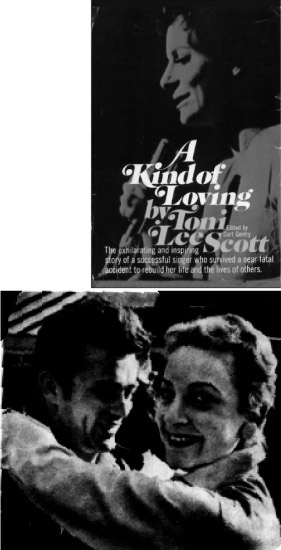
Toni later wrote of her friendship with Jimmy, describing ”the ominous, almost occult portents of their first meeting, and the quick, warm relationship that grew between them.”
Jimmy and Lee had fallen into the habit of ending their respective late night venues with breakfast at Googie’s. Each had noticed the other, but had not yet spoken.
One evening, both of them entered Googie’s, each alone but virtually at the same moment, for a late night supper. Four actors were sitting at a nearby table, loudly unaware that Lee had come in. They were discussing possible dates to escort to the premiere of Judy Garland’s A Star Is Born.
One of the actors said, “Too bad we have to show up with a girl. Will the day ever come when we can be escorted by our boyfriends?”
“Why not take Toni Lee?” one of the actors suggested.
Both Lee and Jimmy overheard the answer. “For a premiere this important, do you think I’d want to show up with a one-legged woman?”
Humiliated, Lee quickly exited from the restaurant.
She later revealed in her memoirs that about two hours before dawn, she’d heard her doorbell ring. When she stumbled to the door, she found it was a man she recognized from Googie’s. Although they’d never spoken, she’d seen him many times before, and somehow, he’d gotten her address.
“Hi, I’m James Dean,” he said. “You know, from Googie’s?”
She was wearing a robe, and he said, “I want you to take off your clothes.”
“What?” she asked, thinking that she might have misunderstood him.
“Your clothes,” he said. “Take them off!”
To her own utter amazement, she claimed that she obeyed his request and stripped. “I didn’t have that fake leg attached,” she said. “Jimmy kneeled down in front of me and ran his fingers over the scars on my stump. He went over the scars one by one, very delicately with his fingers. At the end of his inspection, he gently rained down little kisses on my stump.”
“Don’t listen to those jerks at Googie’s,” he said. “You are beautiful. Forget those morons. Now, get dressed.”
She told him that for a few months after the accident, she’d kept her deformed, scarred, unusable, and withered leg, “But it looked so hideous, I went to a surgeon and had him cut it off.”
After their unusual introduction, she said that in the weeks to come, she grew used to Jimmy ringing her doorbell at three or four o’clock in the morning. According to her, it was a friendship, not an affair.
“We’d have long talks, which always ended with his reassurance that I was beautiful. Later, I’d prepare raisin toast and hot chocolate for his breakfast.”
“Over and over, he kept telling me I was beautiful until I came to believe it,” she said.
“You’ve got a good mind,” he said. “Use it! Develop your insight so you can look behind their words and see why people say them. Learning to appreciate people—that’s hard, but important. But first, learn to appreciate yourself. Because you’re very special, very special indeed. So don’t be smothered under all the ugliness of Hollywood.”
One night at Googie’s, Jimmy and Lee shared a chance encounter with his friend, William Bast, who also wrote about it in his own memoir. Bast didn’t know that Lee was a well-known entertainer in her own right. At the time, she was a blonde in her late twenties, as he remembered it.
“The talk was of motorcycles,” Bast said, “I asked her if she were a cyclist like Jimmy.”
“I was, but I had to give it up,” she said. “I lost a leg. With that, she swung out into the aisle to show me that her leg had been amputated at the knee. Only then did I notice the crutches tucked discreetly beside her, against the wall.”
After their brief three-way conversation, she disappeared into the night with Jimmy, accepting his offer of a ride home on his cycle.
The next time Bast saw Lee at Googie’s, she was alone. “We talked about Jimmy.”
“He’s the greatest guy in this whole god damn town,” she told Bast. “He’s got real guts. Most of the creeps in Hollywood are afraid to even look at my leg. Not Jimmy. He wanted to know all about it.”
Bast asked her about her sex life.
“Not many guys get their kicks fucking a one-legged woman,” she said.
Actually, Lee was living at the time with six handsome young men, each an actor, in an apartment. She prided herself for being able to hobble around on one leg carrying hot chocolate without spilling it. Her six cohorts often rubbed her stump, and she claimed that the rubbing was her greatest joy in life.
Lee also related a dramatic incident that took place one night with Jimmy. She met him at Googie’s when he was with photographer Dennis Stock and his date. It was agreed that all of them would go to this Hollywood party. They would go first to Stock’s place, with the understanding that Jimmy would park his motorcycle there, and that he’d then be driven to the party by Lee, who would drive her own car, following behind Stock in his.
On the way to his house, Stock suddenly slammed on his brakes when a kid ran out in front of his car. Reactively, Lee slammed on her brakes, too. On his motorcycle behind her, Jimmy pressed hard on his brakes, but not fast enough. He was hurled off his bike and, literally under her car.
“I got out of my car, screaming,” Lee said. “I feared I’d killed him.”
Jimmy crawled up off the tarmac, groaning in pain, but smiling to signal that he wasn’t bodily harmed.
“I begged him that night to sell that damn bike,” she said. “Time and time again, I begged him, telling him he was going to kill himself on it. “
One night, he showed up, telling her he’d sold his cycle. “My new transportation is this shiny new Porsche,” he said.
“In it, you’ll be much safer,” she assured him.
Jimmy often dropped by,” she said, “because two of his friends, Nick Adams and Dennis Hopper, lived next door. Nick and I didn’t get along. Sometimes, we’d go out to Googie’s, even Villa Capri. But often, we stayed in my apartment. He’d read from passages in Lord Chesterfields’s Letters to His Son, which seemed to be his favorite literature after The Little Prince.”
Jimmy turned me in the right direction in my life, as a friend, not a lover, although we had a kind of loving.”
The last time she saw him, in September of 1955, he was heading to the car races in Salinas, and he invited her to go along. He was traveling with his mechanic, but he said he also had a station wagon. You’ll be comfortable in it, and we can tow the Porsche behind us.”
She told him she couldn’t go because she had a gig coming up, but “I’ll see you when you get back from Salinas,” she promised him.
“Of course, as the world knows,” she said, “Jimmy never came back.”
One night, Sammy Davis, Jr. was dining at Villa Capri, Jimmy’s favorite restaurant, with Dean Martin and Peter Lawford. The leader of the “Rat Pack,” Frank Sinatra, wasn’t there that night, which was just as well. He didn’t like Jimmy, whose career was soaring at a time when Sinatra’s was bottoming out.
Sammy went over to introduce himself to Jimmy and invite him to a party. He also ordered the maître-d’ to deliver a bottle of champagne to Jimmy and his date.
After that night, Jimmy and Sammy started seeing each other, mostly at parties.
Unlike many young men of his generation, Jimmy had no prejudice against African-Americans. He’d studied dance with Katherine Dunham in New York, and Eartha Kitt was one of his best friends, along with writer Bill Gunn and Cyril Jackson, who taught him how to play the bongo drums.
Jimmy told composer Alec Wilder, “I have a lot to learn from black culture—the music, the dance. Those cats known how to have a good time. They know how to forget their cares and woes, at least for a few hours.”
John Gilmore, Jimmy’s friend, remembered one Sunday afternoon visiting Sammy when he was living at his grandmother’s house, as hard as that is to believe.
Jimmy invited Sammy for a spin on his motorcycle through the surrounding hills, careening around corners at record-breaking speed. Back in front of his grandmother’s house, Sammy climbed off. “Wow!” he said. “Wow, man, what a fucking gas!”
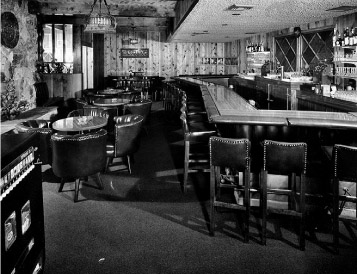
Retro chic: Jimmy’s favorite restaurant, The Villa Capri, in the 1950s.
His grandmother invited them to stay for lunch, the featured staple of which would be a ham-based stew bubbling on the stove. Sammy served a bottle of wine Dean Martin had given him.
They ended up that night at a club, “with the hottest chicks in town.”
As Gilmore recalled, “Jimmy was beating the bongos—stoned out of his mind. Sammy danced and shook the maracas at the hi-fi speakers, while other people seemed to arrive out of nowhere, thickening the group like chunks of starch in his grandmother’s stew.”
By midnight, Sammy was throwing his arms around Jimmy, proclaiming, “This is the cat I love! The one I love!”
Then Sammy and Jimmy kissed each other passionately.
Still stoned the next day, Jimmy wanted to return to Sammy’s, but when he called “grandma,” he learned that Sammy had gone to Palm Springs.
He came up with another idea. Back home, Jimmy wanted to dress up as a chick, with a big blonde wig and red high heels, and with makeup like a Parisian whore.
He wanted Gilmore to be his “stud date” at the Tropical Village, the gay bar at Santa Monica.
***
One night, once again at the Villa Capri, Jimmy dined with Sammy and Eartha Kitt. During that dinner, she told an amusing story of how she’d met Sammy when she was appearing on Broadway in New Faces of 1952.
“He was standing near the stage manager’s door, and I took him for an errand boy, and demanded that he bring me a cup of coffee. Sammy went to get the coffee. When he got back to my dressing room and handed it to me, he told me that someday he’d be a bigger star than I would ever be.”
Both entertainers laughed at the memory of that (embarrassing) incident.
Later on, Sammy got serious, telling them that at parties, he often stood in the corner, looking at Tony Curtis or Robert Wagner across a crowded room. “Female fans nearly dropped dead at the sight of them.”
His left eye was gone [he had lost it in a car accident in 1954] and a deep, dark socket was left in its place. Its eyelid was lower than the eyelid of the remaining eye.
“Sammy always looked like he’s been in a terrible fight, perhaps with a knife,” Eartha said.
“He’s a beautiful man to me,” Jimmy claimed, not really meaning it.
“As a boy growing up, the fear of rejection always crawled beneath my black hide,” Sammy said. “I had an overbite, really crooked teeth. Before I became a celebrity, it was almost impossible to get a girl without paying for some poontang. Now, I’m sought out by gals, often blonde bimbos, but they’re usually there just to meet Frankie or Deano—or else to help me spend my money.”
Eartha and Jimmy were quick to assure Sammy that they loved him for himself.
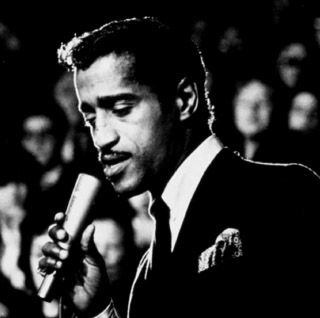
Sammy Davis, Jr. onstage...He attended Satanist orgies with James Dean and “did our thing” in view of other devil worshippers.
“Yeah, but you two don’t put out,” he answered. “I wish you would. I’d take both of you on at the same time.”
“You can’t complain too much,” Jimmy said. “Marilyn Monroe, Kim Novak, and Ava Gardner, from what I’ve heard. Not bad, not bad at all.”
One night when Sammy and Jimmy were out by themselves, he’d asked him why one fingernail was painted red. “That’s a signal to other Satanists. I’m a Satanist, you know. We use the red nail as a signal to each other,” Sammy said. “Actually, I’m on the edge of that cult. I’m not into all that shit about devil worship. I’m in it for the sexual kicks, and there’s plenty of that.”
Jimmy wanted to attend a Satanist orgy, and the following week, Sammy escorted him to a gathering of devil worshippers, where sexual acts among the participants were always part of the ritual. Details are sketchy, but rumors still persist that Jimmy, in front of others, fellated Sammy at the orgy. He’d performed a similar stunt at a late-night jazz club in Harlem, so the rumors were met with some belief.
As Sammy later told Lawford, “It was the right night. There was a full moon. Jimmy was stoned out of his mind. There were no limits about what he could or could not do. He did. I admired him for that. What a little devil!”
“Our friendship was just starting to blossom,” Sammy said after Jimmy’s death. He regretted that he hadn’t approached Jimmy sooner at parties.
“I didn’t take too much notice of him when I spotted him a few times in 1954,” he said. “He was always in the corner somewhere looking depressed and sulky. If someone approached him, he would look up and say, ‘I want to act.’ And then he would slump back into his own world.”
“Hollywood hardly touched him as a person. It was to our eternal shame as a community that we passed him off as a bit of a slob. He was difficult to talk to, but we should have tried harder.”
He also said, “I finally broke through his barrier, and was well on my way to having a new best friend…but then I lost him.”
Sammy once wrote, “James Dean was more than a phenomenon or even a legend. He was far more than a cinematic genius who could act his balls off.”
He was simply the greatest screen experience of all time. The fact that he was cut off in his prime is unfortunate, but irrelevant. The three films he left us will stand as their own monument. He remains indestructible. In only three films, he ruined the careers of hundreds of other aspiring actors who tried to follow him.”
In a subsequent memoir, published after the death of Marilyn Monroe, Sammy drew a parallel between the two icons: “Unlike Jimmy Dean, who never realized his real potential, Marilyn became prematurely spent as an actress because she was never allowed the artistic freedom she craved. After Some Like It Hot, she went into decline. She even began to lose her international clout at the box office. Jimmy, on the other hand, faced possibly a series of some of the greatest motion pictures ever to be made.”
Sammy would also respond to one of the most vicious posthumous attacks on Jimmy ever made. It occurred in October of 1956 and was the opinion of show business biographer Maurice Zolotow, wrote it. His article was headlined “Jimmy Dean Should Be Nobody’s Idol—The Late Actor Was Sadistic, Uncouth, Arrogant, Cruel, & a Filthy Slob.”
“He was surly, ill-tempered, brutal, without any element of kindness, sensitivity, consideration for other, or romantic passion. He was physically dirty. He hated to bathe, have his hair cut, shave, or put on clean clothes. He smelled so rankly that actresses working with him in close contact found him unbearable.”
Zolotov also asked, “What’s so great and beautiful about stepping on the gas, blowing your horn, and speeding down a public highway like a maniac?”
Sammy shot back, “I don’t give a fuck how some of these assholes criticize Dean. He did his number and he did it better than anybody else in the world.”
For the most part, Jimmy and Lance Reventlow, son of the heiress, Barbara Hutton, went their separate ways, but they got together whenever they could to resume their affair.
They not only made love, but attended car races and fussed over their vehicles, discussing the merits of one racecar over another. Mostly, they were concerned with how fast a car could go.
When they weren’t together, Jimmy and Lance sometimes talked on the phone during the early morning hours. One of their conversations lasted for four hours.
Lance told him, “I never know what continent my mother is on.”
Bruce Kessler, Jimmy learned, was Lance’s closest friend. His father, Jack Kessler, had founded Rose Marie Swimwear. “His wife, Nina, was like a surrogate mother to me.”
Jimmy also found out that Lance’s friends were radically different from Hutton’s. He preferred the company of Ronnie Burns, son of George Burns and Gracie Allen, or that of Julie Payne, daughter of actor John Payne. Lance also liked to hang out with Gary Crosby, the abused son of Bing, or Chick Daigh, a race car driver.
“Lance was never true to one person,” Jimmy recalled, although he was dating Jill St. John and planning to marry her. “He gave her a diamond engagement ring that stretched from knuckle to knuckle,” Jimmy said.
“Like Jimmy, Lance, too, had dropped out of college, after attending only one semester at Pomona College. “I’m interested in car racing,” He said. “Why do I need an education?”
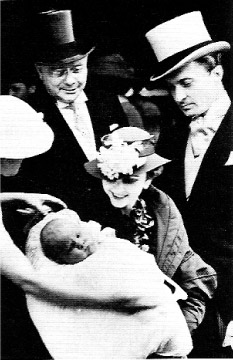
Barbara Hutton holds her fifteen-week old son, Lance in her arms as her father (left) looks on and her husband, Count Reventlow (right), seems to approve.
A photographer caught this troubled family leaving their London townhouse for the boy’s baptism in the Chapel of Marlborough.
Lance told Jimmy that when he reached twenty-one, based on the complicated lineage of his abusive Danish father and American-born mother, he was offered the choice of citizenship, either American, Danish, or British. “I thought it over for twenty seconds and decided to go the Yankee Doodle Dandy route.”
Jimmy often came and went from Lance’s house, which was a modest one on North Knoll Drive in Benedict Canyon. “He was having financial problems because his mother had cut him off at one point.”
There, Jimmy met Dudley Walker, Cary Grant’s former valet, who organized and managed Lance’s bills when he was solvent. “I never had any sense of money,” Lance told Jimmy, “Other than how to spend it. That, I know.”
Jimmy was fascinated by Lance’s fleet of cars, nine in all. His friend offered him the use of any of them “at any time.”
“I have a Mercedes for running errands,” Lance told Jimmy. “A Jaguar for a hot date, and a Rolls-Royce for special events.”
“For car racing, I prefer a Porsche like you have, or a Maserati, perhaps a Cooper-Climax. And just for the hell of it, I keep an old, beat-up Chevy like Howard Hughes drives around in.”
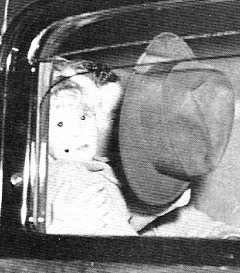
Lance was the by-product of a marriage for which his mother, Barbara Hutton, had renounced her citizenship to become the wife of a Danish count. It was a bitter marriage, leading to endless custody fights over Lance.
A terrified Lance is seen in this photograph from October of 1939, when a bodyguard, Bobby Sweeney, shielded his own face – not that of the three-year old – as reporters stared into the limousine.
Lance was later removed from the car and put aboard the Conte di Savoia to sail across the Atlantic.
Once, Jimmy invited Lance for a drive in the first Porsche he’d purchased. “He was like a kid who’d been given the greatest of all Christmas gifts, even though he had to pay for it,” Lance said. “He was excited by it, and wanted me to admire it, too. Sometimes, with me in the passenger seat, he would take me on a reckless drive through the Hollywood Hills. He treated those curvy roads like a race track. Finally, I told him I didn’t like being in the passenger seat, preferring to be behind the wheel where I belonged. ‘You can sit in the damn passenger seat and be my bitch,’ I told him.”
“For Jimmy, the Porsche was a symbol that demonstrated that he’d arrived as a star, but it was more than that: It was a token of his newfound freedom, and his defiance of the system.”
Jimmy and Lance frequently attended major car races together, after which they’d slip away to some retreat as a means of continuing what Jimmy defined as “our male bonding.”
He rarely discussed Lance, even with his closest friends, other than to say, “He’s a very special guy, very special.”
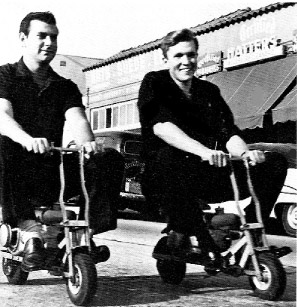
On scooters far too small for them, Bruce Kessler (left) goes for a ride with his best friend, Lance Reventlow,
Lance was the first person Jimmy invited for a spin in “The Little Bastard,” the nickname he’d given his newly purchased Silver Porsche Spyder.
At one point, he even let Lance take the wheel “to get the feel of it,” as they headed east to Little River, California, three miles north of Mendocino.
When they got there, they checked into the Little River Inn, an establishment, built in 1853, which had housed Jimmy and the cast of East of Eden during its filming less than a year before. [Jimmy stayed in room #8 within what is now a California State landmark.]
On May 1, 1955, they drove to Minter Field in Bakersfield, where Jimmy placed third behind Marion Playan in an MG Speck and John Kunstle driving a Panhard Devin.
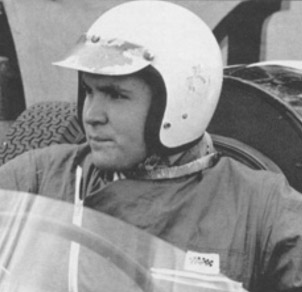
Lance Reventlow, depicted above, and James Dean were destined to die in fiery crashes—Jimmy in a racecar and Reventlow in a small airplane.
That same month, on Memorial Day, they participated in the Santa Barbara Road Races, Jimmy entering the small car, “Under 1,500 cc Production Event,” moving up to fourth place before he blew a piston on his four-cylinder Porsche.
Now, in anticipation of Jimmy’s last race with Lance, both of them were heading in separate vehicles for Salinas, where Jimmy planned to debut his newest Porsche 550 Spyder. But whereas Lance made it to Salinas, Jimmy never did.
As for Lance, after his safe and relatively uneventful arrival in Salinas, where he heard about Jimmy’s death, he said, “My god, I just had this awful feeling. The next crash has my name on it.”
[Except for its timing, Lance’s premonition of his own death was more or less accurate. But it wasn’t until 1972 that he died in a fiery crash in a small airplane.]
During the final year of Jimmy’s life, he entered into an unlikely friendship with character actor Keenan Wynn, son of the famous vaudeville comedian, Ed Wynn. That bonding would ultimately lead to him to Van Johnson, Wynn’s best friend and lover.
Jimmy’s friendship with Wynn began on Thanksgiving Day, 1954, when a mutual friend brought him to the Wynn home for a festive dinner. Jimmy had just completed East of Eden.
Wynn and his wife, the former Shirley Hudson, greeted Jimmy like a member of the family. Wynn had previously been married to the former stage actress, Eve (“Evie”) Lynn Abbott. Following their divorce in 1947, Wynn turned Evie over to Johnson as part of an arranged, studio-sanctioned marriage to camouflage the popular actor’s homosexuality.
Over dinner, Jimmy learned that Wynn shared his fascination with motorcycles. Within days, the veteran actor was teaching him how to navigate open terrain and hills on a cycle.
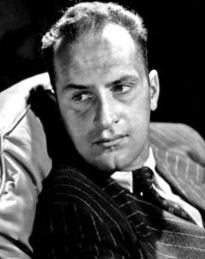
Keenan Wynn...a three-way with Van Johnson and James Dean.
Gradually, Wynn became one of Jimmy’s closest friends, and he set out to learn what he could about him. A New Yorker, Wynn had grown up in a theatrical family that had settled in Hollywood in 1934. In time, he’d appear in hundreds of films and on TV. When Jimmy met him, he was a contract player for MGM, and had recently filmed Battle Circus (1953).
Jimmy admired Wynn’s versatility as an actor, as he could play almost any part except romantic leading men. His forte was affable sidekicks, shifty schemers, sad sacks, villains, con men, and simpletons. He’d gotten his start in Hollywood performing stunt work for Joan Crawford in Chained (1934).
“People thought they were watching Crawford perform those dangerous maneuvers, but it really was moi in drag,” he told Jimmy.
Within a week, Jimmy was introduced to Johnson, a tall, freckle-faced, strawberry blonde actor who’d been a major box office attraction in the 1940s.
When MGM’s major male stars, such as Clark Gable, Robert Taylor, Robert Montgomery, and James Stewart were shipped off to war, Johnson had shot to stardom as “The Boy Next Door,” often appearing in films with June Allyson as the male half of a screen team billed as “America’s Sweethearts.”
During the wartime absence of Clark Gable and Robert Taylor (both of whom had entered the armed services) Johnson was featured in frothy romantic comedies with MGM’s A-list movie queens, especially Lana Turner and Esther Williams.
Jimmy didn’t like those kinds of pictures, although he’d admired Johnson in the military courtroom drama, The Caine Mutiny (1954), in which he’d played an unsympathetic character opposite Humphrey Bogart.
As a kid, Jimmy had seen Johnson in his first hit, A Guy Named Joe (1943), co-starring Spencer Tracy and Irene Dunne.
“Spence had the hots for me,” Johnson confessed to Jimmy. “He even demanded that production on the picture be delayed until I recovered from a horrible car accident.”
“Tracy went for me, too,” Jimmy said.
“I’m not at all surprised,” Johnson said. “I could go for you, too.”
For many months, Jimmy had known that Johnson had wanted to seduce him. When she was dating Jimmy, actress Betsy Palmer, while eavesdropping, had overheard Johnson telling Jimmy during a phone conversation, “I want to cock you.”
“I hope you don’t fall for all that ‘boy next door’ crap from MGM’s publicists,” Johnson said. “If those bobbysoxers in the 40s ever learned that I was a cocksucker, my career would end overnight.”
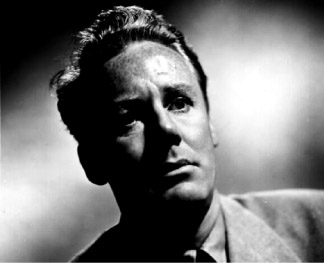
Van Johnson...the actor known as the male half, alongside June Allyson, of the couple billed during the 1940s as “America’s Sweethearts.”
Johnson’s marriage was fraught with difficulties, and he ended up referring to his wife as, “The Dragon Lady.”
Ed Wynn, Keenan’s father, once said, “I can’t keep things straight—pardon the pun. Evie loves Keenan, Keenan loves Evie, Van loves Keenan, Keenan loves Van.”
Evie eventually divorced Johnson, and she later discussed her marriages, respectively, to Wynn and to Johnson: “MGM had to protect its big star from all those rumors about his sexual preference. Unfortunately, I was selected as ‘It,’ the one Johnson should marry. Louis B. Mayer, who had the morals of a cockroach, said that if I didn’t marry Van, he wouldn’t renew Keenan’s contract.”
There was some urgency for a quick marriage. Screenwriter/playwright Arthur Laurents, in his autobiography, claimed that “Van had been caught one time too many ‘performing’ in a men’s urinal.”
Jimmy would later tell Eartha Kitt, “Van is a perfect illustration of the fantasy world that Hollywood projects. Golden boys are actually cocksuckers, femme fatales are muff-divers, and America’s hero, John Wayne, has a small dick.”
He also discussed his involvement with Wynn and Johnson to William Bast. He claimed that he had sat in the Johnson living room for three hours, before their host finally extended an invitation for Keenan and him to retire with him to the bedroom.
“What happened?” Bast asked.
“To cut to the chase, and I don’t want to give a blow-by-blow description, we did a lot of fondling of genitals and exchanging of spit. Van then sucked me off while Keenan fucked him. Then Keenan serviced Van, as I lay back on the pillow, smoking a cigarette.”
“At around three in the morning, I was half awake, and one of them—I don’t know which—was messing around with my ass. I didn’t bother to find out if it was Van or Keenan. What did it matter at that point?”
[In a touch of Hollywood irony, Betsy Palmer, who by then was fully aware of Van Johnson’s sexual interest in Jimmy, ended up working with him when he was on his last legs in 2003. They appeared together for three performances of A.R. Guerney’s Love Letters at a theater in Wesley Hills, in Rockland County, New York.]
The “usually heterosexual” Arthur Loew, Jr. was a surprise choice as Jimmy’s last male lover. Born in 1925, he was seven years older than Jimmy.
His maternal grandfather, Adolph Zukor, had founded Paramount Pictures, and his paternal grandfather, Marcus Loew, had launched both Metro-Goldwyn-Mayer and the Loew’s theater chain. His father, Arthur Loew, Sr., had once been president of MGM.
Loew Junior was a minor film producer, turning out such B-list pictures as Teresa (1950), with Jimmy’s future girlfriend, Pier Angeli; Penelope (1966) with Natalie Wood, Jimmy’s co-star in Rebel Without a Cause; and later, after Jimmy’s death, The Rack (1956), starring Paul Newman.
During Arthur’s production of Teresa, he began dating one of its stars, Pier Angeli, but within weeks, he’d switched his romantic interest to her twin sister, Marisa Pavan.
One afternoon, Arthur arrived at the Pierangeli household in Brentwood to retrieve Marisa for a date. On lawn chairs in the distance, he spotted Pier and a young man, each of them holding a script.
“Who is that guy?” Arthur asked Marisa.
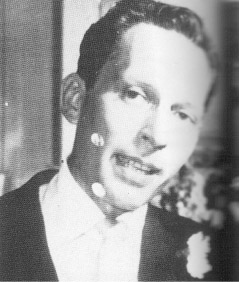
Arthur Loew, Jr.
“Don’t disturb them,” she answered. “Pier is rehearsing with this actor, James Dean.”
“Who in hell is James Dean?” he asked.
“He’s this fabulous actor from New York.”
“Never heard of him,” Arthur said.
“You will,” she predicted.
Arthur may not have heard of Jimmy, but Jimmy had never heard of him, either.
Unlike his illustrious and hardworking ancestors, and despite brief work stints as a drama critic and sports reporter, Arthur was a playboy who only dabbled in the occasional production of films. He was better known for a widely publicized romance with Elizabeth Taylor. Later, he dated Joan Collins, but she broke it off, having defined their relationship as “too platonic.”
Arthur had just ended an affair (which had included an engagement) to Jimmy’s closest female friend, Eartha Kitt.
Amazingly, despite their friendship, Eartha had never described the depth of her relationship with Arthur. In fact, she had barely, if ever—at least to Jimmy—mentioned him at all.
Their love affair had ended horribly: The Loew family had ferociously objected to their heir’s association with a woman of color, and relentlessly pressured him to end it, which he did. At the time of Jimmy’s association with Arthur, Eartha was far away, on singing engagements in Manhattan.
That day, in the Pierangeli’s living room, Arthur asked Marisa, “Who is this shit out in the yard? So he can’t be disturbed while rehearsing? Who in hell does he think he is? Laurence Olivier?”
Within two months, Keenan Wynn, one of Arthur’s closest friends, arrived with Jimmy at Arthur’s house on Miller Drive. Jimmy’s apartment at 1741 Sunset Plaza Drive, was nearby.
When Keenan introduced him to Arthur, he remembered the sight of him rehearsing with Pier. Also sitting in the room was Rod Steiger, Jimmy’s actor friend from New York, who had already assured Arthur that Jimmy was one of the best actors performing in teleplays in Manhattan.
“Arthur was prepared to dislike Jimmy,” Steiger said. “But when they started to talk, it was love at first sight. I had already warned Arthur that Jimmy had to be handled with kid gloves or else he might explode into a temper fit.”
“Both Arthur and Jimmy had a wicked sense of humor, and they really got off on each other,” Steiger said. “Keenan and I found ourselves sitting and talking with each other, as those two lovebirds played the mating game. They did everything that night except fuck, and, for all I know, they did that, too, after I left.”
Steiger had departed an hour earlier. As the evening wound down, Wynn turned to Jimmy. “It’s time for us to hit the road, kid, and ride our machines down those winding roads.”
He later told Van Johnson and others, “Jimmy did something wild and impulsive. At the door, after I said good night to Arthur, Jimmy locked him in a tight embrace and gave him a kiss. Not a peck on the cheek. I hadn’t seen a kiss like that since Toomey kissed Wyman.”
[Wynn was recalling Regis Toomey and Jane Wyman in a 1941 movie, You’re in the Army Now. Their kiss was the longest up to that point in cinematic history, lasting three minutes and five seconds, or four percent of the film’s duration.]
“The last words I heard was Arthur telling Jimmy, ‘I’ll see you tomorrow night at seven,’” Wynn recalled.
After that, Jimmy practically moved into Arthur’s household. Originally, the maid had prepared the guest room for him, but later discovered that the bed had never been slept in. Only the sheets on Arthur’s bed had been used.
Even before Arthur met Jimmy, he virtually threw open his doors every night at five o’clock for “sundowners,” as part an ongoing house party that attracted tout Hollywood.
On any given night, you might hear Judy Garland accompanied on the piano by Oscar Levant. Perhaps a drunken Errol Flynn would show up, a few hours later trying to bang out a melody on the piano with his erect penis.
Marilyn Monroe dropped by on occasion, as did Desi Arnaz and Lucille Ball, as well as Kirk Douglas, Eddie Fisher, James Mason, and Danny Kaye. Guests were likely to include Paulette Goddard, Jane Powell, June Allyson, Ginger Rogers, Ethel Merman, and Debbie Reynolds.
Jimmy soon learned that Arthur was having a sometimes affair with Susan Strasberg, the daughter of Lee Strasberg of the Actors Studio. It was at Arthur’s house one night that he met Susan, with whom, he too, would launch a brief fling before he made Giant.
Jimmy was impressed with Arthur’s light-hearted, charming style, and his outgoing personality. As he noted one night, “He could even keep Milton Berle in stiches.”
He was surprised to learn that Stewart Stern, who at the time was writing the filmscript for Rebel Without a Cause, was Arthur’s cousin. “Unlike his cousin, Arthur, Stern was bookish and always very serious,” Jimmy said.
Elizabeth Taylor and Paul Newman were also among Arthur’s friends, as were Farley Granger and Shelley Winters. Beginning in the late 1940s, much of young Hollywood had started to gather at Arthur’s house to watch “Uncle Miltie” (Milton Berle) on The Texaco Star Theater. At the time, Arthur possessed one of the few television sets in Los Angeles.
One night at Arthur’s house, Jimmy met Janet Leigh, who told him “After Elizabeth (Taylor) finished with Arthur, she turned him over to me. That was before Tony Curtis.”
“One night, Arthur introduced me to his friend, Sammy Davis, Jr,” Leigh continued. “Sammy told me I hadn’t lived until I’d had a black dick buried deep inside me.”
“That Sammy!” Jimmy said, not wanting to reveal anything.
Often, after a date with Pier, Jimmy would arrive at Arthur’s house to spend the night. Sometimes, they preferred to dine at home; at other times, they went out for dinner. Since Jimmy wasn’t properly dressed for such clubs as Mocambo’s, where Arthur had more-or-less permanent and direct access to his favorite table, the two men went together to offbeat places, the type with sawdust and beer spilled on the floor.
Two months later, Jimmy ran into Steiger, who asked him, “How are things going between you and Arthur?”
“Great, man, just great.”
“Until he met you, I always thought he was straight,” Steiger said.
“All men are straight until they meet the formidable James Dean.”
One night, Jimmy invited Arthur and his cousin, Stewart Stern, to a preview of East of Eden. Neither man had seen Jimmy perform in anything, not even any of his teleplays.
Jimmy himself had not seen the complete cut until he attended this sneak preview.
In his biography of James Dean, Venable Herndon described what happened after Arthur became aware of his friend’s success and talent as a film star:
“It was an overwhelming experience,” Arthur said. “So beautiful, so fantastic. It must have been like the first night someone went to see John Barrymore perform in Hamlet. It was such an awakening, an eye opener. Here was this guy I’d been palling around with for quite a while, yet I had no idea who he really was.”
After the screening, the three of them [Arthur, Steiger, and Jimmy] went to a bar in the Valley. As Arthur later told Steiger, “Jimmy was still my best buddy, but I no longer related to him just as a bedmate to keep my feet warm at night, but as a star. A Star is Born, starring James Dean instead of Judy.”
“He pulled no star act with me, however,” Arthur said. “He was still the crazy, lovable, yet infuriating guy he always was one night when Walter Pidgeon came by. I was driving him [Pidgeon] to dinner. I exited through the gate at the end of my driveway and headed out onto the street. Suddenly, blinding lights almost caused me to have an accident. I fully expected a head-on collision.”
Later, he learned that both Jimmy and Keenan Wynn had trained their motorcycle lights onto him and were roaring at high speeds directly into the front of his oncoming car. Before they collided, both men swerved their bikes to the left and right, respectively, of Arthur’s vehicle, each of them yelling at the top of their lungs.
“Later, when Jimmy dropped by, I really lit into him,” Arthur said. “Fun is fun, but all of us could have been killed. I blamed the stunt on Keenan, who should have known better.”
“Jimmy was this terrific personality,” Arthur said. “A real cuckoo. It was very informal at my place, a house party atmosphere. Lots of people unless we wanted to be alone. No stiff cocktail party atmosphere, as is so often seen in Hollywood.”
Jimmy later told Bast about the wildest, most intimate party presumably his host ever gave. Guests included Artie Shaw (the musician, who at one time or another married both Ava Gardner and Lana Turner), Errol Flynn, and Robert Mitchum.
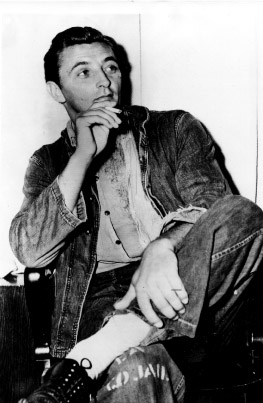
Robert Mitchum...do you want catsup with this raw hamburger?
“Mitchum and I got stoned. Mitchum went into the kitchen and pulled off all his clothes and covered his chest with catsup. ‘I’m a raw hamburger,’” he told us.”
Then, according to Jimmy, who relayed it to Bast, Flynn immediately took advantage and got down on his knees, and begin fellating Mitchum. Shaw provided the musical accompaniment to the act.
While all this was going on, Jimmy went upstairs and emerged in a gown and high heels borrowed from the wardrobe of Arthur’s mother.
“Then I did my best Mae West impersonation,” Jimmy told Bast.
Suddenly, the doorbell rang and rang, followed by a loud pounding on the door. “It’s the police,” a strong, masculine voice yelled out. A fully dressed Arthur answered the door.
As Jimmy recalled, “The world’s best-looking and most macho policeman stood there. He looked like a Viking god. Think Sterling Hayden in a movie from the early ‘40s.”
But instead of a raid, the policeman told Arthur he’d been summoned to investigate a burglary, reportedly still in progress, in the neighborhood.
“Fuck the robbery,” a drunken Arthur told the cop. “You can arrest Mitchum for pot and indecent exposure, Jimmy for speeding, and Flynn for stashing away a thirteen-year-old girl in one of my bedrooms upstairs. As for Artie Shaw here, make it bigamy. He married Ava Gardner before divorcing Lana Turner.”
“The cop seemed like a real regular guy, so Arthur invited him to join the party,” Jimmy said. “The robbery in progress was forgotten. After a few drinks, the cop told us he’d really come to Hollywood to be a male stripper at private parties. And that he’d like to try out his act on us.”
“Piece by piece, his clothing came off, beginning with that gun. He really put on an act for us. Finally, when he showed it hard, Errol reached for it, and using it as a rudder, guided him into one of the downstairs bedrooms. Neither of them was seen again until a few hours later.”
“Then the cop stood at the door, in uniform, fully dressed,” Jimmy said.
“Thanks for the party, guys,” he said. “Real Hollywood stuff, the type I was told went on here, but hadn’t hooked up with until tonight.”
Arthur Loew, Jr. had not only been previously involved in romances with Pier Angeli and her sister, Marisa Pavan, but he’d also had a torrid affair with Eartha Kitt. The black singer was still Jimmy’s best woman friend and “soulmate.”
“Jamie was always full of surprises,” Eartha told the co-author of this book, Darwin Porter, one night in Key West when she was filming the film adaptation, The Last Resort, of his novel, Butterflies in Heat.
“I’d been cut off from Arthur, and I was hoping for a reconciliation. I called at two o’clock in the morning on a private line that fed directly into his bedroom. Then, I got the shock of my life. Jamie was in bed with the man I still loved.”
In her memoirs, she wrote, “I still felt that the love Arthur and I had for each other was stronger than any outside influence. I still believed he’d stand up to the Loew family, who opposed any possibility of an interracial marriage between us.”
In desperation early one morning, she’d put through a call to him, hoping he had changed his mind about her. “Perhaps I wanted him to say, ‘I love you too much to let anything come between us.’”
“When Jamie came onto the phone, I felt like I was about to have a heart attack,” Eartha said years later in Key West. “I knew him so well. I could tell by his voice that it wasn’t a case of two men bunking together. I knew they were lovers. Jamie was loving the one man on earth I most desired. At first, my reaction was, how could he do this to me? I wanted to kill him. But I told my heart to settle down. After all, I’d rather Jamie be making love to Arthur than for him to be in bed with some blonde floozie like Jayne Mansfield.”

Eartha Kitt with Arthur Loew, Jr.
A photographer captured the tension building between them over pressure from his powerful family about their interracial coupling.
“Knowing I had caught him red-handed, Jamie told me that Arthur was in the tub taking a long hot bath.”
He said, “The whole Loew family has moved in. Everyone is unhappy and very cold, and no one says much of anything to each other.”
“Arthur has been very quiet,” he went on. “He stays in his room most of the time, drinking throughout most of the day. The only person he lets into his bedroom is me. I offer what comfort I can. The operators at MGM warned me to not let any calls from you get through to him. His mother is here. This afternoon, she told me that her son would marry you only over her dead body.”
“That article about you and Arthur in Confidential really blew the lid off,” Jimmy told her, speaking in a very soft voice. “His mother told him that if he married you, it would mean the death of his grandfather. He’s in his seventies and has suffered two recent stokes. He’s confined to his suite at the Waldorf Astoria in New York. The pressure is really on Arthur.”
“The one man I want to be the father of my child is being emotionally blackmailed,” Eartha responded. “I wish he’d defend his position like a man who’s not afraid to reach out for his happiness.”
“Take care of him, Jamie,” she said, trying to conceal the jealousy in her voice. “I still love him, you know. And I love you, too.”
“I will, and I know you must be heartsick and filled with anger and frustration. Please don’t turn on me. The friendship that Arthur and I developed just happened. It was just one of those things.”
“It’s always just one of those things,” she said. “Sounds like a refrain from a song by Cole Porter.” Then she hung up.
The next morning, Mrs. Arthur Loew, Sr. confronted Jimmy when he was in the study listening to music. “Please understand this,” she said to him. “I know about you and my son, and I want it kept very quiet, very discreet. My family has a reputation to maintain. Forgive me for saying this, but I’d much rather that Arthur be secretly involved with a faggot than publicly married to a nigger woman.”
***
Back in Hollywood, Eartha checked into a suite at the Sunset Towers. Later, with two escorts, both of them black and both of them jazz performers, they went to Ciro’s for dinner.
She later wrote that as she was ordering food, “the hair on the back of my neck began to send messages. I knew that he was there. I could feel him. He was coming closer. Or was I going mad?”
It was Arthur. He looked down at her, telling her he was hosting a late night party, and asked her and her friends if they’d like to drop in.
She didn’t commit herself, but later, with her escorts, she drove to his house.
“It was Jamie who opened the door,” she said. “We fell into each other’s arms, but something was different. ‘What have they done to you? I feel your spirit is gone.’”
He laughed. “Ah, Kitt, you’re on one of your voodoo trips again.”
Soon after her arrival, she retreated from the guests in the living room, heading to her favorite part of the house, Arthur’s study. He followed her and joined her on the sofa. Without saying a word, he took her hand.
In about ten minutes, Judy Garland entered the study, followed by Jimmy. She stood, confrontationally, in front of Arthur. “You bastard! You are so much in love with this girl you can’t see straight, and you’re too fucking weak to do anything about it. Arthur, when in the fuck are you going to grow up and be your own fucking man?”
Then, she stormed out of the room. Arthur jumped up and followed her. Jimmy noticed that the two of them became engaged in an animated conversation outside the door. He sat down on the sofa with Eartha and took her hand.
Two hours later, it was time to go. Jimmy walked Eartha to the door, where her escorts awaited her. Arthur was there, kissing Garland good night.
He turned to Eartha. “Sunset Towers, right? I’ll call you tomorrow.” Although he had kissed Garland goodbye, he had only shaken Eartha’s hand.
The next day, that call from him never came in.
Two days later, Jimmy called her and invited her to Arthur’s home on Miller Drive. He was at the door to let her in. Arthur was nowhere to be seen. He asked her to go with him in his Porsche to retrieve some records, including some of her own recordings, from his own residence.
When they got back, Arthur still had not appeared. “Give him time, Kitt,” he said. “He’s got to get rid of a lot of shit that he’s been trying to get over for years. You know, family stuff. He’s trying, but you’ve got to give him time.”
“With this encouragement, Jamie and I parted,” she later wrote in her memoirs.
She left the next day for Las Vegas, where she was performing in a show.
The following Sunday, she was in Las Vegas, in her dressing room. A chorus girl came in and announced, “I just heard over the radio that James Dean is dead in a car crash.”
Eartha later wrote about her reaction. “I mourn you, Jamie, not so much for your death, but for cheating me out of your presence in my life. How dare you cheat me of that? You took the only friend I had, my one true friend. Jamie, you cheated me. I won’t let you leave me. I will hold your spirit with me. You won’t leave me, Jamie. Ever!”
She later admitted, “I fell to pieces. Jamie was long gone. So was Arthur. Forever.
***
In 1956, Arthur Loew, Jr. established the James Dean Memorial Fund at the Actors Studio in honor of his former friend.
***
In 1959, Eartha was dining with her friend, Jack Dunaway, in Hollywood. “Oh, did you hear?” he asked her. “Arthur Loew just married Tyrone Power’s widow. She was three months pregnant. It was the right thing to do.”
He was referring to actress Deborah Ann Minardos, who Arthur married and then divorced within the same year.]
“Nicolas Ray, the director, told me that James Dean was ‘intensely determined not to be loved—or to love.’ Jimmy himself told me that the only success is immortality. In that he succeeded brilliantly. In spite of his small oeuvre of only three pictures, the world remembers him and not dozens of guys who made more than fifty movies.”
—Vampira
If you were alive and living in Los Angeles in 1954, you knew who Vampira was. Resembling a more sexually alluring version of Morticia Addams, she appeared on the then-new medium of television like an exotic voodoo priestess.
Born Maila Elizabeth Syrjäniemi in Finland in 1922 (some sources say 1921), she emigrated to the United States and adopted the last name of her famous uncle, Olympic runner Paavo Nurmi, emerging as Maila Nurmi.
Although she failed as an actress, in 1944 she’d been cast on Broadway with Mae West in a play Mae had written, Catherine Was Great. It was produced, incidentally, by Elizabeth Taylor’s future husband, Mike Todd. West, fearing that the younger girl was upstaging her, booted her out of the play.
Migrating to Hollywood, Maila supported herself by posing for pinup photographs in men’s magazines such as Gala.
After several more failed attempts at acting, she hit it lucky. Attending a masquerade ball, she dressed as a female vampire, complete with ghoulish white makeup, evoking a Charles Addams cartoon. She won first place in costume design.
A TV producer at station KABC spotted her and offered her the role of television hostess for a series of horror films they were going to run. She gladly agreed and officially changed her stage name to “Vampira.”
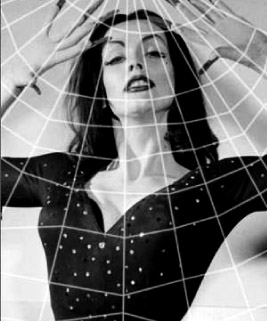
An exotic & campy cult celebrity from the early days of television: Maila Elizabeth Syrjäniemi, aka Maila Nurmi, aka VAMPIRA.
During her brief reign, Vampira ruled the night, terrorizing audiences with her just-risen-from-the-coffin appearances, many of them configured as introductions to blood-sucking horror movies.
Her series ran for 16 episodes in 1954, with frequent reruns throughout the rest of the decade. For each of them, Vampira made a spectacular entrance amid dusty spider webs and dry ice fog. As the camera zoomed in on her vampire-deadly face, she’d let out a piercing scream before introducing the movie of the night. Usually, she reclined seductively on a skull-encrusted Victorian sofa.
Like a Zombie-mate of Bela Lugosi, she accessorized herself with all the trappings of Fright Night. Her drag included long, heavily painted fingernails in midnight black, with a mane of ravencolored hair, and a big-busted, slim-waisted, black-as-night outfit set off with fishnet hosiery.
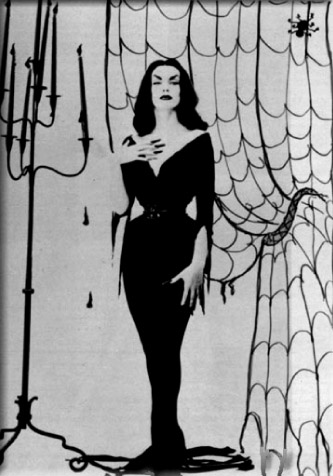
Vampira...Mae West viewed her as too much competition.
Her eyes were heavily mascara-ed which contrasted with her blood-red lipstick. In character as a vampire-inspired sex kitten driven by a powerful thirst for fresh blood, she introduced such films as Devil Bat’s Daughter and Revenge of the Zombies.
[In 1989, she lost a $10 million lawsuit in which she had charged that Cassandra Peterson’s late-night hostess “Elvira” had pirated her character.]
She was an overnight sensation and developed a campy cult following thanks partly to a ghastly appearance that made her look like she’d just emerged from a haunted coffin.
When she wasn’t emoting in front of a TV camera, Vampira became a kind of “Mother Confessor” to the Bad Boys of Hollywood, notably and most famously James Dean, her on-again, off-again lover. She also hovered over Paul Newman and Tony Perkins, and was privy to their off-the-record romance with each other.
In that punitive era, these secretly bisexual men found it difficult to talk—with the noteworthy exception of Vampira—to a woman and make her privy to their affairs. Vampira, or so it is said, gave birth to the term “fag hag.”
Googie’s, that zippy, populuxe-style coffee house where stars gathered on Sunset Strip, was a major venue during the last summer of Jimmy’s life. A new woman was about to enter the scene.
Vampira arrived nightly at Googies, emerging from a long black hearse, which she’d purchased from a funeral home. She called it “The Black Death.”
Nurmi recalled meeting Jimmy. “One night, he walked into Googie’s, and I was devastated by his male beauty and those blue eyes. He was a bit short, and I’d been seduced by men with more buffed bodies, but the kid had something, and I wanted a part of it. I thought he was a knock-out.”
“I was coming down from an affair with Brando, who had just kicked me out on my ass after only three nights, and I was shopping for some fresh new meat to devour. However, I suspected that one of the pretty boys at Googie’s would get him before I had my chance. How right I was. His name was Tony Perkins.”
Nurmi would later claim that during that fateful summer, Jimmy, his close friend, Jack Simmons, and herself became almost a part of a “love triangle. We were almost never separate.”
That, of course, was a gross exaggeration, although for a while, they did form an intense relationship, mainly because of their shared interest in the occult.
“Sometimes, I went home to my husband…what’s his name…I forget.”
Nurmi only pretended she didn’t know the name of her husband. Dean Reisner was a former child actor in silent films, and he later became a screen writer, penning the script of Dirty Harry. Newman turned it down, the career-making role going to Clint Eastwood.
“Jack, Jimmy, and I would stay together at Schwabs Drugstore until it closed, later moving next door to Googie’s,” she said. “After midnight, we’d wander off to some experience, perhaps unmentionable.”
“When I first met Jimmy, I was the star, and he was completely unknown. Fans of Vampira would push him aside to get to me. He’d be lost in a sea of what he called ‘asses and elbows.’”
He referred to Vampira as “the Witch.”
“But during our relationship, our positions changed. Fans pushed me aside to get to him.”
Jimmy held court almost nightly at Googie’s, sometimes lingering till long after the sun came up. Vampira was always there among his devoted listeners.
Almost nightly at some point he would speak about the implacability of his upcoming death. “Live fast, die young,” was his motto.
Both Jimmy and Vampira shared the same ghoulish humor. For a publicity photo, Vampira once wandered through a local cemetery, announcing to the press that “I’m attending my own funeral.”
Vampira cultivated a devoted following of campy gay men in the 50s, and many of them often performed free favors for her just for the privilege of being in her company. One man arranged her hair; another designed outfits for her, and one, Freddie Brandell, drove her around Hollywood, without charge, in his car, a luxurious Cadillac, a gift from his rich father.
At the peak of her fame, Vampira had at least eight gay boys on call. Each of them was introduced to Jimmy, and each developed a crush on the sexily handsome and increasingly famous young actor.
Dean referred to the boys as “flamers,” and rejected each of their invitations for sex.
Freddie, who himself would die in a car crash in 1966, developed the most overwhelming crush of them all on Jimmy. He told Vampira, “I’m gonna have him if it’s the last thing I do on this earth. I’m mad about the boy.”
Jimmy would abuse Freddie, send him on stupid errands, or even give him his dirty underwear to wash. Vampira protested the abuse. “Girly boy loves it,” Jimmy told her. “He’d even eat my shit if I asked him to.”
In some respects, Vampira agreed with that.
She claimed that she was surprised by how intensely Newman bonded with Tony Perkins and Jimmy Dean. “Tony and Jimmy were wild boys,” she claimed. “They should have been put away somewhere. They were such tormented souls. In contrast, Paul seemed only mildly disturbed, but he drank a lot. It was a difficult time for him. He couldn’t make up his mind if he wanted to be straight or gay. I think Paul was basically straight, and had a great love for women. But back in those days, a good-looking gay guy could get him into bed.”
“I dated Tony, but he always took me home early, usually at nine o’clock, and I had to settle for a kiss on the cheek. With Jimmy, I saw some action.”
“One night I took Jimmy to meet my friends at the Maleficarum Coven, the oldest coven of witches in Los Angeles.”
Jimmy was only momentarily intrigued with these witches, later telling author Joe Hyams, “It’s all a bunch of cow pies, but weird and kind of fascinating.”
Once, Vampira and Jimmy attended a ghoulish Hollywood party of witches and warlocks. She came dressed in her Vampira drag, and he came as Boris Karloff impersonating Frankenstein.
“Even after Jimmy became a star and could afford to treat us once in a while, he would pay only his part of the check—nothing else,” Nurmi said. “He was a real miser.”
“The first time Jimmy invited me back to his apartment, I was shocked to see a noose hanging from the ceiling,” Vampira said.
“He told me he kept it there in case he wanted to commit suicide in the middle of the night. Of course, who was I to be surprised? At the time, I was driving around in a funeral hearse. I also noted that he kept a lot of books on black magic scattered around the room. One night he threw a party. What a motley crew of friends he had. A lot of bongo players and dope smokers, and a lot of ‘actors’ who had never acted in anything. Dope, dope, and more dope—that’s all that crowd was interested in. Jimmy could have had any beautiful woman in Hollywood, but he was sleeping with guys.”
“He was also going through his amputee period, dating this ugly woman who had only one leg. Jimmy told me that she was the leader of a gang of beatnik thieves who made their living robbing the homes of rich movie stars. That night, Jimmy stripped down to his underwear and rubbed her stump. To judge from the rising bulge in his underwear, that turned him on big time.”
[This unidentified woman, of course, was not Toni Lee, the well-known entertainer. It was another amputee with whom Jimmy became involved.]
In her way, Vampira loved Jimmy, but was aware of his dark side, “which was darker than the black nail polish and black gown I wore to introduce those horror movies,” she said. “I agreed with Elia Kazan, who claimed that Dean ‘was a punk but a helluva talent.’ He also said that ‘Dean liked cars, waitresses—and waiters.’ Sometimes, though, he dated high on the hog.”
“Jimmy even managed to seduce Marlon Brando, Paul Newman, Steve McQueen, and Merv Griffin. Even Howard Hughes found out what his underwear was hiding, but had to pay for it.”
“He often took me out and around as his date,” Vampira said. “One night we showed up at a party in Malibu. Jimmy encountered a former lover, who denounced him in front of everybody, claiming he dated women only for publicity. ‘Nobody in his right mind thinks you’re straight,’ the queen shouted at him.”
By now, Jimmy was used to having that accusation hurled at him.
Sometimes, Nurmi, with Simmons, would ride together in “The Black Death,” while Jimmy would precede them on his motorcycle. “He was reckless,” she said, “riding with his hands held above his head and gyrating his hips like in an old Carmen Miranda movie. I thought he might be killed instantly, since another vehicle was likely to run into him. I just knew he was going to kill himself one day, sooner than later.”
In addition to Simmons, Newman and Perkins were also fixtures in Jimmy’s life. “Tony was carrying on with Jimmy, even though he was involved in a torrid romance with Tab Hunter, I think,” Vampira said.
Jimmy revealed his affair with Tony to William Bast. “He’s tall and skinny, but he’s got a decent sized cock. He’s so god damn shy. When he tries to talk and relate to people, he practically gets lockjaw. When he does speak up, he glances nervously around the room. He doesn’t speak words, he spits them out. Late at night, though, he opens his trap and I can’t get him to shut up. I’ll wake up and find he’s still talking. What a contradiction.”
“His favorite form of sex involves dressing me in black and having me slip in through his bedroom window as ‘The Kissing Bandit’ before I rape him, violently, biting his lip as I do until I draw blood.”
Television director James Sheldon, one of Jimmy’s closest friends from his days in New York, once asked Tony why he didn’t date starlets for publicity purposes.
“If a pill existed that would make me like women, I’d grind it into the ground with my foot,” he said.
In the spring of 1955, director William Wyler wanted Jimmy to play a supporting role in Friendly Persuasion, Jessamyn West’s affectionate book about conscience-torn Quakers during the Civil War. Jimmy was excited to work with Gary Cooper, but since East of Eden had made him a star, he was advised by Dick Clayton not to accept this or any other supporting roles.
“I’m so glad he didn’t,” Tony said. “I got the part. It made me a star, too. I got an Oscar nomination.”
According to Nurmi, “Jimmy and I often ended our night at Googie’s just as Paul and Tony were beginning their day. We’d be wasted and Paul and Tony would come in all bright eyed and bushy tailed. Tony would order a dozen prunes and a glass of freshly squeezed orange juice, but Paul wanted the works, bacon and eggs. On some mornings, he even ordered a greasy cheeseburger for breakfast.”
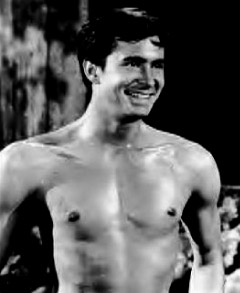
Tony Perkins...inviting rape.
“Even though I knew the boys were bed-hopping like rabbits in those days, they seemed devoted to each other,” she said. “Tony would tell us goodbye and then hitch a ride down Sunset Strip. He always got picked up right away. No sooner did that sexy young stud stick out his thumb than we could hear the screech of brakes from some gay male eager to pick him up and give him a ride to the studio . . . or whatever.”
Nurmi remembered one evening when Jimmy, Tony, and Paul all went with her to Googie’s. “Paul and Jimmy climbed up on a soapbox that night. Jimmy said he was not going to become some performing monkey for the studio machine. Paul also claimed that he was not going to be turned into some paper doll created by a studio. ‘Surface glamour doesn’t interest me at all,’ Paul said. ‘These Hollywood stars can have all the false glamour they want. The estates in Beverly Hills. The swimming pools. Their fancy cars. Of course, the easy sex isn’t bad.’”
Jimmy agreed with him.
“Tony shocked Jimmy and Paul when he took a different view,” Nurmi claimed. “‘I’m going to climb the ladder of success out here,’ Tony vowed. ‘Go to the right parties, meet all the VIPs. I want to be a movie star and enjoy all the trappings. You guys can ride your motorcycles into the desert and hang out with rattlesnakes. Not me. I want to drink champagne with the big boys.’ At that point, Jimmy took his glass of freshly squeezed orange juice and slowly drizzled it over Tony’s head.”
“Tony never fell for Jimmy,” she said. “If he was in love with anyone, it might be Tab. I’m sure he enjoyed sex with Jimmy, but as we found out later, Tony wanted to be James Dean, or at least ‘the next James Dean.’ He perhaps figured that by seducing him, some of Jimmy’s talent would be passed on through semen.”
“On separate occasions, Tony managed to entice Paul and Jimmy to walk barefoot with him from the Château Marmont along the entire length of Sunset Strip to Doheny,” Nurmi claimed.
“Those guys were before their time. In the 60s, thousands of hippies were walking barefoot along the Strip. Perhaps those boys launched a future fad.”
“The boys had their secrets,” Nurmi said. “Tony was a tormented soul who really wanted to go straight, but he was screwing around with guys all the time. It was hopeless. Paul was the straightest of the bunch. But in those days, he had a wild streak of adventure in him and could be had. I knew Jimmy had already had him. They were rivals, though.”
“Whereas Paul tried to suppress his dark side, Jimmy wanted to explore his, and that included lots of gay sex. Paul and Jimmy also took out their adventurous side through car racing, flirting with death.”
“All the boys back then were going through a period of sexual experimentation. Hollywood pretty boys were fucking each other, occasionally screwing gals, and going to orgies. What a glorious time that was—the Eisenhower 50s.”
Jimmy later denied it, but Nurmi on at least three occasions managed to lure him into her bed, draped in black sheets. “Frankly, I don’t think Jimmy’s prick was up for it at the time we bonded. I fear I didn’t turn him on with my witch act.”
***
Freddie Brandell had not given up on his scheme to seduce Jimmy. One night, a ghoulish opportunity arose that this schemer soon set into motion.
He remembered the pictures, published in Life, that Dennis Stock had taken of Jimmy. Some of them depicted him posed in a coffin—a display model in a general store back in Fairmount, Indiana.
Vampira’s career as a TV ghoul had suffered from some recent bumps and grinds. When her show was canceled, although none of them accepted, she approached some of its competitors in the hopes that they’d pick it up.
As it happened, her friend and “gopher,” Freddie, who was hoping for a career as a studio publicist despite the fact that it was going nowhere, convinced Vampira that her sagging career could be saved through a publicity scheme he had devised.
“We’ll have Dean lying in a coffin, pretending to be dead, and you’ll hover over him, looking like the most glamorous vampire who ever invaded a cemetery.”
At first Jimmy was reluctant, but one night, after a liberal consumption of drink and drugs, he agreed to it. Freddie drove them and a photographer to a funeral home owned by the uncle of one of his friends. There were no dead bodies there on the night of this ghoulish party’s arrival.
Before Jimmy agreed to crawl into the casket and lie down, pretending to be dead, Freddie offered him a final drink. The young actor made a big mistake in downing the drink in one gulp.
Inside the coffin, Jimmy jokingly sat up, in emulation of a corpse rising from the dead, but finally drifted off into a coma on the satin upholstery inside the casket. Vampira just assumed he had fallen asleep.
She had another appointment, and asked Freddie if he’d hang around and drive Jimmy home. Planting a kiss on Jimmy’s lips, she left the funeral parlor accompanied by the photographer.
The next afternoon Freddie, told Vampira what he’d done the night before. Before Dean got inside that casket, Freddie had slipped him a vodka-based Mickey Finn. Not knowing the drink was drugged, he drank all of it, fast.
“After you and that guy left, I went and opened the back door and let in four of our friends,” Freddie confessed. “Jimmy was knocked out, and we were sure that he’d remain that way for a long time. We lifted him from the coffin and placed him on a mortuary slab where we stripped off every piece of his clothing.”
As Vampira listened in horror, Freddie told her more. “As you know, Jimmy has denied us any sex for a hell of a long time, even though all the guys have been panting for him. Unconscious on that marble slab, he could deny us nothing. We did everything we could think of, sexually speaking, before the rooster crowed. We left him lying on that slab to be discovered by the mortician in the morning. I hope he realized that Jimmy was still alive and didn’t embalm him.”
Vampira let out one of her famous screams and slapped Freddie’s face. “You little fool! Don’t you know each of you guys could get ten years or more for a stunt like that? Get out! I never want to see you or any of your so-called friends again. All of you are sick. Sick!”
She immediately called the photographer and told him to destroy all the negatives. She didn’t want a picture with her in it to be used in evidence in case a trial was later held and the boys’ rape of Jimmy exposed in open court.
***
After several months, Jimmy tired of Nurmi and had nothing good to say about her to gossipy Hedda Hopper, who published his comments.
“I don’t go out with witches, and I dig dating cartoons even less,” Jimmy claimed. “I have never taken her out, and I should like to clear that up. I resent her exploiting our acquaintance for publicity.”
“I have a fairly adequate knowledge of the occult,” he said. “I have studied The Golden Bough and the writings of the Marquis de Sade. I was interested to find out if this girl was obsessed by satanic forces. She knew absolutely nothing. I found her a novice with no true interest in the occult, except her Vampira makeup.”
Biographer David Dalton wrote: “Vampira cut off all her hair in a last attempt to get Jimmy Dean’s attention, but he would not respond to her trick-or-treat threats. Finally, she actually cast a spell on him! ‘Oh, Ye Powers of Mwuetsi Moon Men, Come to My aid!”
Dalton continued: “She drew Oola-Oola signed with thrice-charmed ashes. Snakes and lizards! She was using black magic against Dean! She administered the dreaded rites of the eight-by-ten glossy, cutting out his eyes and ears from the photographs with a little gold dagger, incanted fiendish curses (“by the Fates of Ghastly Guchkakunda!”), made a black-and-white voodoo doll to represent his body and performed the macabre ceremonies in her room, which was said to resemble some witch doctor’s shack back in Haiti.”
In one of Hollywood’s tragic ironies, a few weeks later, on September 30, 1955, Dean suffered a broken neck, and subsequent death, during a car accident while recklessly driving his Porsche near Salinas, California. His ruined body was placed in a coffin at the Kuehl Funeral Home on Spring Street in Paso Robles, California, for shipment to Indiana. This coffin would be the final one.
Shorly after Jimmy’s death, Nurmi posed for a postcard photo depicting herself sitting beside an open grave. The inscription read: “Come and join me!”
Published less than a week after Jimmy died, and interpreted as a nuanced but clearly implied reference to his violent and unexpected death, her campaign catalyzed a backlash of protests. In Vampira’s words, “Letters from Jimmy’s fans poured in by the tons.”
Later, Liberace hired Vampira to appear in Las Vegas as a minor part of his nightclub act. She told him, “You’re the only person in show business who has been nice to me since Jimmy died. I liked Jimmy so very much. It was the little things. I gave him a Tokyo-made ear picker, so he’d quit using those damn toothpicks to clean his ears.”
In Vegas, Liberace told her that he’d tried to offer Jimmy money, as a means of enticing him to visit him in Nevada, but he never would fly out to see me.”
Three years after Dean’s tragic death at the age of twenty-four, Vampira met with director Elia Kazan to discuss the actor’s growing legend. “I don’t like it,” Kazan said. “His fans are glorifying a Dean that never existed. They see him as a little waif brutalized by Hollywood. He was a sicko with talent. He hated everybody, mostly himself. I’d call him a half-baked pudding of hatred. If you actually tasted that pudding, it was poison.”
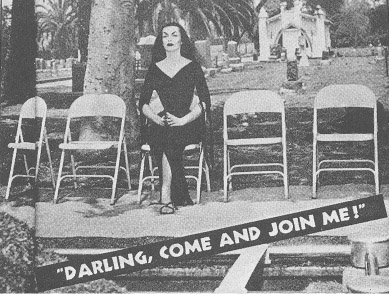
In the immediate aftermath of Jimmy’s death, Vampira, the ghoulish neurotic of the night, shamelessly tried to twist it into a tasteless publicity stunt for herself. In this replica of a postcard she distributed, she poses in front of an open grave, with the implication that she’s inviting him to join her during her “walks with the living dead.”
The tasteless prank backfired, provoking massive outrage from Jimmy’s fans.
In 1959, Vampira made one last attempt at stardom when director Ed Wood, who made the most ridiculous movies ever filmed, cast her alongside Bela Lugosi (“Count Dracula”) in the schlocky, not-even-funny-enough-to-be-camp Plan 9 from Outer Space. Critics have, since then, defined it as “the worst film of all time.” It was the last film Lugosi ever made—an inglorious end to a fabulous and otherwise legendary career.
In 1994, when the historic reality of Vampira had evolved into a cultish and very campy icon brought back to the screen, she was too old to play herself in Ed Wood, Tim Burton’s tribute to the F-movie director. It starred Johnny Depp. Vampira was portrayed by the Goth-inspired Lisa Marie Smith, a model and actress from New Jersey who billed herself simply as “Lisa Marie.” [No, not the one associated with Elvis Presley and Michael Jackson.]
In 2006, two years before her death, Vampira’s life story, or at least a heavily edited version of it, would be relayed in a documentary by Kevin Sean Michaels entitled Vampira: The Movie.
She never benefited financially from her fame. In later life—almost destitute—she sold handmade jewelry. At her lowest point, she lived in a garage and became a cleaning woman in a restaurant.
Unlike her friend, James Dean, who died young, Vampira would not meet the Grim Reaper until January 10, 2008, in Los Angeles. She’d lived a turbulent, unhappy life before finally—at the age of 85—releasing her last breath.
In her later years, she proclaimed, “The world doesn’t have much use for a broken-down old fag hag. Where are all my golden boys of the 50s? Of course, they were sleeping with each other and rarely gave me a tumble, but I loved them all the same.”
During the last summer of his life, James Dean moved into an apartment on Sunset Plaza Drive, overlooking Sunset Strip. Rogers Brackett had brought him to this street when he was the producer’s kept boy. He could now thumb his nose at Brackett and pay his own rent. “Now, Brackett runs from his landlord, who’s demanding back rent.”
Googie’s remained Jimmy’s favorite hangout. When Bast spotted him there with the gay actor, Tony Perkins, Jimmy stopped to acknowledge him and introduce a former lover (Bast) to a new lover (Perkins).
“Tony and I have been hanging out with a lot of spooks,” Jimmy said. “I’ll give you a ring some night.”
Bast stood watching as Tony and Jimmy wandered off together into the night.
The “spooks” Jimmy referred to were no doubt members of what the press called “The Night Watch.” After midnight, these young men and women, on the fringe of show business, convened at Googie’s. Bast described them as “the lonely, the alienated, and the disenfranchised, trying to meet other kindred souls.”
Newspapers made outrageous claims against the coven, labeling them “Satanists who practice the black arts, including eating both excrement and human flesh.”
The Warners publicity department was horrified that Jimmy’s name would be dragged into this group, which was becoming increasingly notorious and was under scrutiny by the police.
“Jimmy was not the man I had known and loved,” Bast claimed. “He was dealing with the darker side of his personality and, for a time at least, found comfort with these unsavory aliens of the night. When I dared ask him about that during another encounter, he told me he had an answer.
“I like bad people,” he said. “I guess because I’m so god damn curious about what makes them bad.”
As Jimmy moved into the final weeks of his life, he saw less and less of Bast, who was writing teleplays. Their long ago sexual contact in the California desert never blossomed into a love affair. Jimmy had turned elsewhere.
Finally, that day in late September that Bast had long anticipated had arrived. Jimmy was killed in a car crash on the road to Salinas.
Bast later wrote, “I’d spent much of the time of the past five years, between the time we met and the time he died, in his thrall. I couldn’t have guessed then that I would spend the next five decades in his shadow.”
Throughout the rest of his life, Bast, in spite of his own accomplishments as a writer, would be famous for having known James Dean. Fueling that fame would be his authorship of two books and a TV movie focusing on details associated with the life of his former friend.
As the years passed, Bast’s statements about Jimmy grew increasingly ambivalent and bitter. Friends sometimes interpreted his unflattering comments about Jimmy as “traitorous.”
He told the press, “In real life, Jimmy was not an extraordinary person. If anything, he was rather bothersome.” On Entertainment Tonight, Bast defined Jimmy as “cocky and arrogant.”
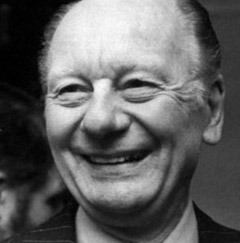
Sir John Gielgud...”Were you and Jimmy lovers?”
Yet it was his very association with Jimmy that made Bast famous in certain circles. “Dean was very, very shrewd in the way he used people. He knew what he was doing. To get where he got, he kissed a lot of asses, and he hated himself for that.”
For the rest of his life, whenever Bast was introduced to people, they more or less asked the same question.
On the Left Bank of Paris at an all-male party in the 1950s, Bast met John Gielgud.
“Ah, yes, William Bast,” Gielgud said. “The young man who knew James Dean. Tell me, my dear, were you lovers? I had Brando, but never Dean.”
In his final known comment about Jimmy, Bast told his remaining friends, “When one dines with the devil, it’s best to use a very long spoon. Of course, I loved him. There is no denying that. Not a day goes by but what I don’t wonder what it would have been like, had I moved in with him again, this time as his lover. Could I have trusted him with my love, my devotion, my life? I doubted it then, and I doubt it still, but the biggest question persists. Would I really have risked it, for better or worse, at least to find out if it would have worked?
During the final year of his life, Jimmy bonded with Lee Bracker, a well-dressed insurance agent.
In the Warner Commissary, Leonard Rosenman, one of Jimmy’s closest friends, brought the two men together. Bracker was married, the father of two girls, Alison and Lesley.
Two young men of the mid-century came together, and within a week or so, they were “best pals and confidants.”
Their friendship did not begin all at once. It evolved gradually, beginning one night when Jimmy arrived, unannounced at the Rosenman home. He discovered that the couple were out, and that Bracker had volunteered to babysit for them.
Jimmy decided to stick around, and they talked for hours, discovering their mutual interests.
Before the night was over, Jimmy had intrigued Bracker with Porsches and car racing.
A friendship was formed that would last until Jimmy’s death. Bracker and Jimmy would soon be meeting at night, arriving in separate vehicles at the top of Mulholland Drive “to go for a spin,” in whichever of the several cars jimmy was driving at the time, since there wouldn’t be many cars on the road at that hour.
Bracker was straight, and he made it clear in a personal memoir, published in 2013, that his relationship with Jimmy had nothing to do with sex. He was of the opinion that Jimmy’s homosexual life ended when he arrived in Hollywood to film East of Eden.
Jimmy was an expert at keeping various facets of his life separated, especially when he was with his straight friends.
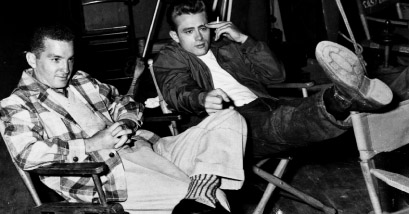
Lew Bracker with James Dean...call it a “bromance.”
It was Bracker who accompanied Jimmy when he went to purchase his infamous Porsche Spyder 550, little knowing that it would become his friend’s coffin. Coincidentally, Bracker, the week before Jimmy’s death, in his capacity as an insurance salesman, drew up an insurance policy on his life.
[James Dean died without leaving a will. Even though he’d made only one payment on his insurance policy, the company owed Jimmy’s heir $100,000. It is not known who Jimmy would have selected as an heir to his estate.
In the absence of any specific instructions designating a beneficiary, Winton Dean, Jimmy’s father, received the policy’s the entire benefit. It was ironic that he’d given Jimmy so little money—almost none—and he ended up profiting from his son’s death.]
Two days before, Jimmy had confronted Bracker, telling him, “you and I have got to get married.”
“To each other?” Bracker asked in astonishment.
“We both have to get married to women and have families. That’s what we both want. That’s what we both need.”
“He never talked to me like a man worried about cutting life short,” Bracker later wrote.
Slowly, Bracker came to know his new friend, who was becoming more famous every day. “Jimmy would be bothered when someone would say he was mean and disrespectful. Actually, he wasn’t. They took silence to mean he cared little or nothing for them. They didn’t have the insight, or didn’t care to exercise that insight, in knowing that he was a shy boy that just didn’t know how to approach them. Instead of making an attempt to approach him, they just wrote him off.”
Some of Jimmy’s closest friends, who knew about his relationship with Bracker, felt he was in love with his new friend, who shared so many of his mutual interests.
“Stanley Haggart had that view: “I never met Bracker, but the way Jimmy talked about him made me aware of just how strong his feelings were for this man. But Jimmy was no fool. He was completely aware that Bracker didn’t go that route, and I doubt if he ever made a pass at him. He didn’t want to ruin what he saw as an important new figure in his life. Of course, Jimmy wouldn’t be the first gay man who fell in love with a straight man.”
From all reports, Bracker and Jimmy enjoyed many a “crazy, fun-filled day” in the bittersweet and halcyon summer of 1955, as Jimmy’s life edged toward a cliff.
Bracker recalled hanging out with Jimmy beside a swimming pool one hot afternoon, inventing a parody of a “swords-and-sandals” movie with a Biblical theme. “We had Mary having an affair with Joseph and getting her pregnant,” Bracker said. “They decided to hit the road because no one believed that cockamamie story about an Immaculate Conception. During their journey to Bethlehem, Joseph tried to tune out Mary’s kvetching.”
In their contrived scheme for a screenplay, Joseph suddenly flashes on a moneymaking scheme: “From this mensch, we can make a living. Look what Moses did with the burning bush tale and that slab of stone with ten scratches on it. I’m broke and can’t afford a room. I’ll find a barn; you’ll have my boy, and I’ll round up a few goat and pigs. And I’ll get three guys from Central Casting with costumes borrowed from Hope and Crosby’s Road to Morocco movie. We’ll be in business.”
Before his fateful trip to Salinas, Jimmy stopped by Bracker’s house and pleaded with him to accompany him to the car races. Bracker refused, preferring to stay home for what he called “My most pleasurable pastime, a USC football game.”
The last time Bracker saw Jimmy was when Jimmy, rebuffed, called back to him during his exit, “Okay, it’s your funeral.”
In his memoir, Bracker related how dazed he’d become when he received news about Jimmy’s sudden death. As the years went by, he summed up his involvement with Jimmy by writing, “His physical presence in my life has ended, but our friendship continues.”
In January of 1955, as Jimmy experienced a California winter, his romantic life with women consisted mostly of a series of “chicks picked up at Googie’s,” as he confessed to William Bast. On the mornings after his adventures, he usually didn’t bother to remember the name of his conquest of the previous evening.
As he complained to Bast, “Sex with these mannequins isn’t turning me on. These gals really aren’t interested in me. The want to brag about fucking James Dean, the new movie star.”
Just when he was about to give up on women, Lilli Kardell came into his life. When Jimmy started dating her, virtually no one in Hollywood had heard of her.
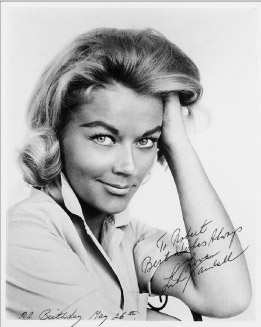
Lilli Kardell...Jimmy’s last female flame.
She was beautiful and Swedish. She had come to Hollywood to become the next Greta Garbo or Ingrid Bergman, both of whom had also been from Sweden.
She had been discovered by a Stockholm-based agent working for RKO films. As a secretary, she’d been employed because she had a good command of English, which she’d been taught in school.
Soon, at the age of eighteen, she was “shipped” to Hollywood. Her diary recorded that she met Jimmy on February 19, 1955, early in the year he died.
Ironically, Kardell was introduced to him by Arthur Loew, Jr., his male lover. The Swede and the farm boy from Indiana would soon become engaged in an affair that would endure through his last summer.
Author Joe Hyams described Kardell as, “The quintessential starlet, a pretty brunette with almond-shaped eyes and a big bosom. She was good-natured, forgiving, and generous with her favors. She was also dedicated to the craft of acting. Before seeing Jimmy at night, she took singing, dancing, and diction lessons during the day.”
Soon, Jack Simmons, Jimmy’s closest and most faithful male companion, met Kardell. “Lilli was quite bovine,” he said. “Jimmy and I called her ‘The Cat Lady.’”
[As the Cat Lady, she must have been more “feline” than “bovine.”]
Author Donald Spoto claimed, “Kardell could have passed for a reverse image of Jimmy himself. They wore their hair similarly, they wore matching bathing suits, and they favored black leisure outfits. As with Pier Angeli, he favored exotic foreign ladies to escort out in public, following the example of Marlon Brando.”
At their first public outing, Jimmy and Kardell were accompanied by Tennessee Williams and Anna Magnani.
While the women were at table, Tennessee had a brief chat with Jimmy at the bar. Later, to Darwin Porter, in Key West, Tennessee recalled that evening: “I asked Jimmy if he were in love with this young Swede. Had she made off with his fickle and most unreliable heart?”
“Tenn,” he answered. “You know me well enough to know by now that I’m a deceitful lover, not to be trusted out of one’s sight. I’m sure you once fell in love with me, and I’m equally certain I broke your heart. That’s what I do. When biographers record my life story years from now, I’m sure at least one of them will entitle their bio, James Dean, The Heartbreaker.”
“I’ve never really loved anybody in my life,” Jimmy confessed to the playwright. “I tried to have an affair with myself, but that didn’t work out. As for Lilli, I’m just hanging out for the sex, and sometimes, even that bores me. I hate to confess this, but my greatest sex has been with myself. I failed in an affair with myself, but the sex is great.”
“I know what you mean,” Tennessee said. “Masturbation is, after all, one of life’s pleasures when one’s sexual partners prove unreliable.”
Jimmy held up his right hand. “This is my most reliable sex partner. This hand never fails me. I’m sure she’ll be there servicing me when I’m old and gray.”
“If you ever become old and gray,” Tennessee said. “Time herself, that relentless bitch who destroys all of us, both mentally and physically, will never claim you. You’ll outrun her, I’m sure.”
“Does that mean you’re predicting an early death for me?” he asked.
“You know in your heart that’s how your story will end.”
***
For his first trip out of town with Kardell, Jimmy drove her to Palm Springs for a car race at a track alongside the foreboding concrete runway of the Palm Springs Airport, the arrival point for many visiting celebrities from Hollywood. To Kardell, Jimmy cut a dashing figure, dressed in black racing coveralls with a black-and-white checkered cap. Before the beginning of the race, he told her, “I know I’m going to win. I can feel it in my bones.”
She reminded him to be careful. “Bones can be broken!”
It was late March, but the noonday sun already made the desert resort feel like August.
About twenty cars were competing, driven by such ace drivers as Ken Miles and Cy Yedor, along a grueling 2.3 mile track. The starting positions were drawn by lot, and Jimmy was “seriously pissed off” at his car’s subsequent placement in the fourth row at the rear. “I’ve been assigned to the fucking boondocks,” he complained.
The moment the flag went down, he jammed his foot on the accelerator and took off, zooming past cars who had been assigned better starting positions. He cut wide around them on the outside, almost scraping the left door of a driver from San Diego. “The fucker almost killed me,” that driver complained in a formal protest he later filed against Jimmy.
As the first quarter-mile was reached, Jimmy had moved up to fifth position. Never letting his foot leave the accelerator, he was leading the pack at the end of the hazardous first lap. His Porsche could go no faster than one-hundred miles an hour. His aim was to beat Yedor and Miles in their MG Specials.
To his disappointment, Jimmy ended the race in third position. However, judges, on a technicality, disqualified Miles, so Jimmy was moved up to second place. That meant he would carry off the Silver Trophy. “I should have won the gold,” he complained to Kardell.
“On the track, I learn about both people and myself,” he told her.
“Speed fascinated Jimmy,” Kardell said. “He loved it so much, it would ultimately lead to his death. It was not just some passing fancy, but an all-consuming passion.”
After the race, Kardell and Jimmy got into a tiff, perhaps because she was seen having a drink with the dashingly handsome Robert Evans, who would later, from 1967 to ’73, be in charge of production at Paramount.
“What are you doing with him?” Jimmy later asked her, angrily. “I hear he got his start selling jockstraps in New York.”
[Evans would later marry actress Ali McGraw, who would eventually divorce him—with disastrous consequences for her movie career—to marry Steve McQueen.]
In her diary, Kardell wrote: “Jimmy and I were angry at one another. Idiotic evening. Finished with myself drunk, and sleeping in a rented car.”
The two made up the following day, and he took her to the Shadow Mountain Resort and Golf Club in nearby Palm Desert to celebrate his victory. There had been two races.
In one of them, he came in first, beating out several veteran drivers.
Miles, an English driver, told the press, “Dean is a reckless daredevil, even if he doesn’t give a fuck for his own life, he should not try to kill the other drivers. Car racing is not a bullfight, his other favorite sport. The bloody little punk just doesn’t get that.”
[Miles would later die in an accident during a car race in Riverside, California.]
In her diary, Kardell recorded details about the second night of their weekend together. “Terrible atmosphere between us. He behaved in a ridiculous fashion and ignored me completely and flirted with other girls. Finally, we reconciled, and he drove me back to Los Angeles. He slept a little, and we made love. Everything is well between us now. I hope.”
Jimmy spent the following night in the bed of Arthur Loew, Jr., on Miller Drive, where he’d been given the keys to come and go as he wished.
Kardell later described what it was like being “Jimmy’s girl.”
“He would all of a sudden just leave and go away and find some buddy of his and start talking about cars. He would be gone for half an hour or more. He was very moody. He could one minute be very deep in thought about something, and then snap out of it, and in the next minute, he’d be on the floor dancing and making some joke, and it was just no use getting mad at him for that kind of thing, because that just didn’t do any good. You just had to understand—that was the way he was.”
In April, while Jimmy was filming Rebel Without a Cause, he came down with the flu. Both Maila Nurmi (Vampira) and Kardell took turns bringing him hot soup and making hot tea for him.
When he recovered, he did not date Kardell exclusively. Not only was he involved sexually with certain members of the cast from Rebel, he was also seen on occasion with April Channing, a Broadway showgirl, and with Dana Wynter, who had arrived in Hollywood from her native London, hoping to make it in American pictures. Lucy Marlow, who had had a small role in Judy Garland’s A Star Is Born, was also seen on his arm, as was Julie Robinson, a dancer with Katherine Dunham’s troupe. Jimmy publicly referred to Robinson as “my mambo instructor.”
In August of 1955, perhaps against Jimmy’s wishes, Kardell talked to a reporter from Modern Screen. “Jimmy is an ice man. Some of the things he does, it is because he is youthful. It takes time to handle fame. But he really is very kind. They tell me he doesn’t smile enough. Not true. He smiles much. He has a good sense of humor.”
As that summer of 1955 came to its inevitable end, Kardell perhaps realized how hopeless any long-term commitment from Jimmy would be. She began dating other men, especially after Jimmy left for Texas to shoot Giant.
On September 30, 1955, she wrote in her diary: “Jimmy Dean, my only love, died on his way to Salinas for the races. Auto crash. Please take care of him, God, and let him be happier now than before. I can only hope that I will find Jimmy in some other person. My thoughts will always be with you, Jimmy. Goodbye forever. I love you, and will never forget you and the memories we shared.”
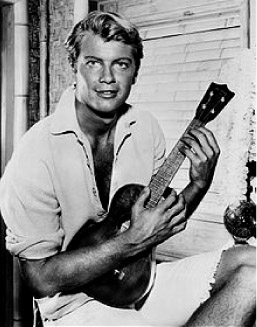
Troy Donahue...No replacement for James Dean.
[Kardell never found Jimmy in another person. In 1958, she married an insurance executive, but the relationship ended disastrously. Alleging cruelty, she divorced him after less than a year.
Her next engagement was to an actor as different from Jimmy as a mongoose is from a snake. She began an affair with Troy Donahue, that handsome blonde pin-up who became a cardboard fixture in films during the late 1950s and early 60s before his Hollywood fame flickered and died. Ironically, he once made a film called Live Fast, Die Young, which is the most-used epitaph applied to Jimmy.
It was rumored that Donahue’s motivation for hooking up with Kardell was entirely based on the fact that she’d once been “Jimmy’s girl.”
Donahue and Kardell never married. One night, she was rushed to the Cedars of Lebanon Hospital, suffering from a severe beating. When she recovered, she sued Donahue for $60,000 for assault and battery. The case was settled out of court.]
In the wake of the death of James Dean, studios both in the United States and Europe would market some emerging actor as “The New James Dean.”
Of all the inheritors of the throne, Christopher Jones, who for a while was married to Susan Strasberg, came the closest to physically resembling Jimmy, based on his blonde hair and slender yet strapping physicality. He reigned briefly in the 1960s as the reincarnation of Jimmy.
For a while, the extraordinarily handsome Maxwell Caulfield, who once appeared frontally nude in a play in New York, was also promoted as another James Dean. Caulfield’s well-muscled physique elicited more praise than his acting in any film he made. He was truly a rebel without a good movie role.
In West Germany, the bisexual Horst Buchholz was hailed as the next James Dean. He was known for his brooding intensity, his tousled hair, and his sexy appeal. He wasn’t really Jimmy, although he did wrap his car around a tree one day. Unlike Jimmy, he survived.
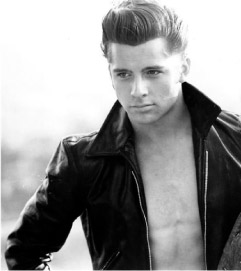
Maxwell Caulfield...Perhaps the body of a Greek god was not enough.
For a period in the 60s, Alain Delon was sometimes marketed as “The James Dean of France.” He rose to stardom in Purple Noon (1960), a Franco-Italian production based on Patricia Highsmith’s The Talented Mr. Ripley.
In the immediate aftermath of Jimmy’s death in 1955, the executives at Paramount decided that Tony Perkins, Jimmy’s sometimes lover, should be defined as their reincarnation of James Dean. Alert to the public hysteria that followed in the wake of Jimmy’s death, the studio wanted someone to pick up his mantle. Tony seemed their best candidate.
Along with many others, Paul Newman was taken aback by the false claims that Tony Perkins was making about the closeness of his relationship with Jimmy. He even asserted to reporters from fan magazines that he and Jimmy had roomed together in his apartment on Sunset Plaza Drive, which was not true.
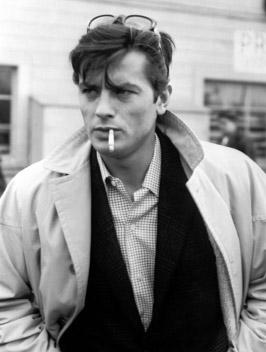
Alain Delon...The French had their own James Dean.
Jack Simmons, who had actually been Jimmy’s roommate, was very resentful. “No one can replace Jimmy Dean,” he said. “Certainly not Tony Perkins. Jimmy was all internal and driven, while Perkins is sort of mechanical, physically plotted, and contrived. There is no comparison to Jimmy, except in Perkins’ own head.”
Photoplay magazine disagreed: “We need an actor to fill the shoes of James Dean. Tony Perkins is an ideal candidate to fill those shoes. He does offbeat things like Dean and makes good copy.”
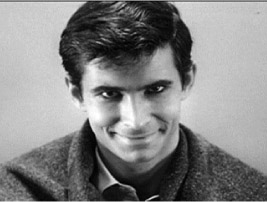
Tony Perkins, as he appeared in Psycho.
Ultimately, it wasn’t Perkins, but Newman who moved in to take over roles that had been slated and conceived for Jimmy. The first of the lot was a boxing picture, Somebody Up There Likes Me (1956), the cinematic saga of Rocky Graziano.
Newman complained to Rod Steiger, “Whereas Perkins is courting it, I’m having this new James Dean image thrust upon me. I’m the unwilling actor taking over his roles both in the movies and on TV. When will the newspapers stop making these stupid comparisons between Jimmy and me?”
“When the next Paul Newman comes along,” the veteran actor told him, cynically.
In Somebody Up There Likes Me, Newman found himself co-starring with two of Jimmy’s former lovers, each of them of different genders—Sal Mineo and Pier Angeli. Newman himself had already been sexually intimate with Pier during their work together in The Silver Chalice.
When they came together on the set, she said to him, “We both loved Jimmy, and now we’ve lost him. Fortunately, I have Vic Damone, and you have Joanne Woodward.”
Both of them found it ironic that in The Silver Chalice, Newman was a Jew playing an Italian-American, and she, a bona fide Italian, was playing his Jewish girlfriend.
When Newman had first encountered her, she was suffering from a broken ankle, the result of a fall in the stairwell of her home. Until she recovered, he sometimes carried her between her dressing room and lunch in the studio commissary.
After he’d done that two days in a row, he lingered for a few hours after their return to her dressing room, since neither of them was due that afternoon on the set.
When an assistant came to summon Pier to the set, he found Newman in his jockey shorts with Pier, together in the shower.
“The first day Newman met Sal Mineo on the set, the young man was still mourning the loss of his friend. Mineo had been cast in Somebody as Graziano’s friend, Romolo.
Fourteen years older than the Bronx-born Sicilian-American, Newman congratulated him on his Oscar nomination for Rebel Without a Cause. “I thought you and Dean were terrific,” he said. “I’m sorry he’s gone.”
“Not as sorry as I am,” Mineo said, appearing on the verge of tears. “I noticed you work out every day. I’d like to join you”
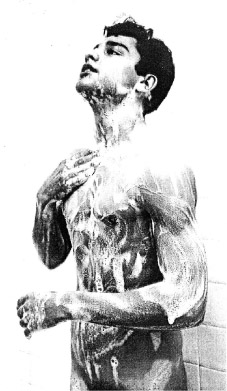
Getting sudsy with Sal Mineo.
Aware of Mineo’s gender preference, Newman warned him, “Okay, but working out is all we’re going to do. I don’t intend to replace Dean in your life.”
At the gym, the two men worked out for more than 90 minutes before Mineo joined Newman in the shower. “You can look, but don’t touch!”
“I promise.”
As Mineo later confessed, “I didn’t keep my promise. As Paul was showering, before he knew what was happening, he found me on my knees. He told me to leave him alone, but I didn’t. Finally, he said, ‘Go for it, kid. I’m too far gone to stop you.’”